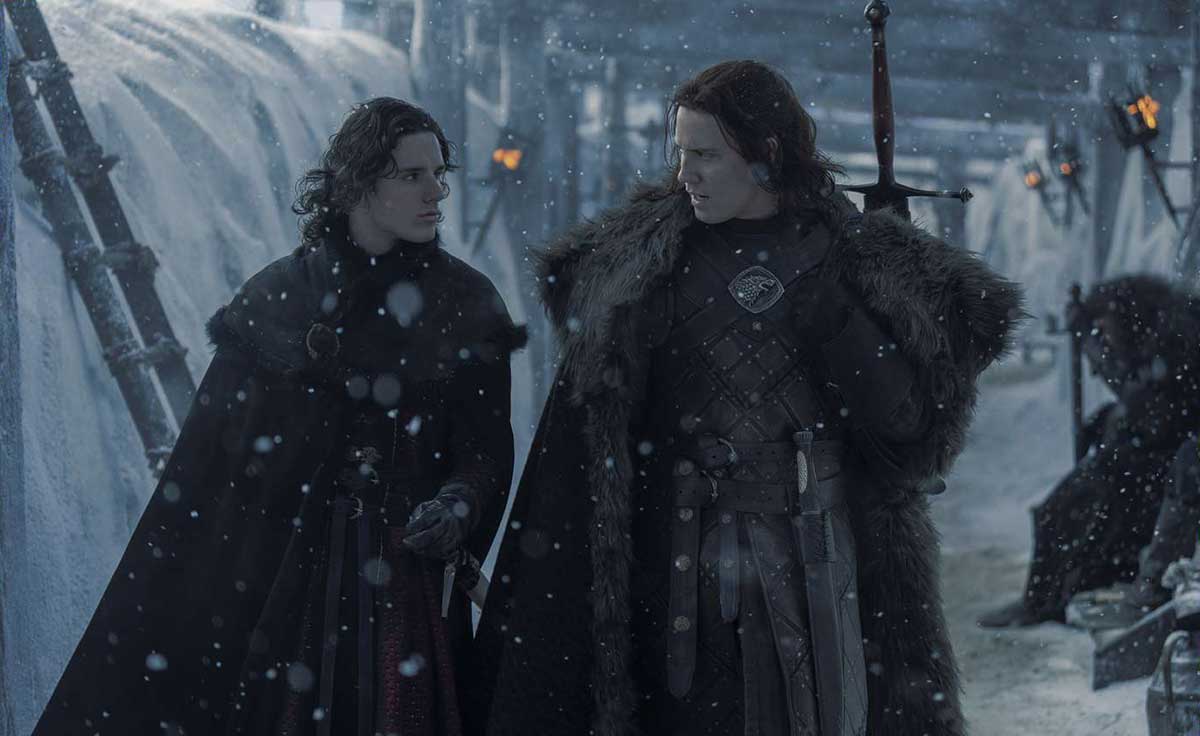Editorial
Relive The Forgotten Game of Thrones Locations of Northern Ireland in these 27 pictures!
Discover these beautiful Game of Thrones filming locations in Northern Ireland.
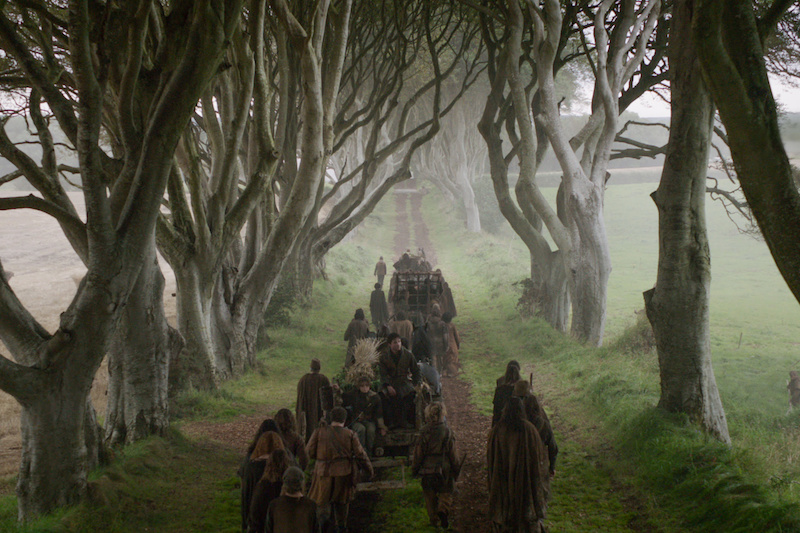
It has been over ten years since Game of Thrones first aired on HBO. The show was filmed in various stunning locations across multiple countries, which contributed significantly to the show’s visual appeal and storytelling. Most of the locations where the series was filmed are in Northern Ireland.
This article explores the locations where Game of Thrones was filmed and why they are popular tourist destinations. Join us as we look at the scenery that contributed to the show’s success and why people continue to visit these places.
Read More: Who is Daeron Targaryen? Everything you need to know about the House of the Dragon character
Artist Eddie Mendoza brings us the landscapes and castles of Westeros as never seen before, with thirteen stunning illustrations, including a bonus fold-out poster.
1. Larrybane Quarry, Larne: The Stormlands
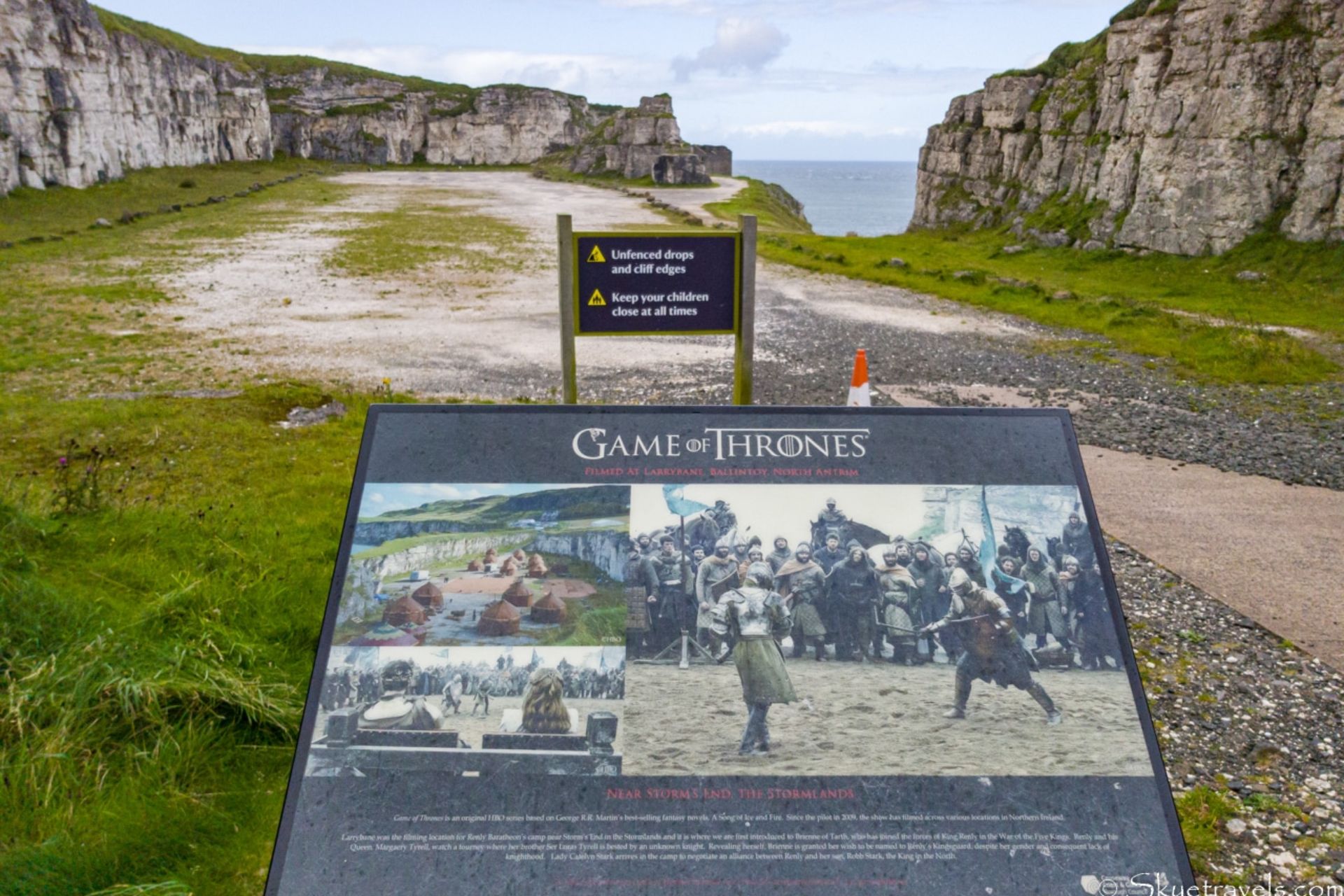
Credit: Skyetravels.com
Larrybane Quarry, located on the rugged coast of Northern Ireland, was featured in Game of Thrones during season two, serving as the Stormlands. It is most memorable as the site where we were first introduced to Brienne of Tarth. In this scene, the old chalk quarry was transformed into Renly Baratheon’s camp, where a grand tournament takes place.
In the episode, Renly Baratheon and his wife, Margaery Tyrell, watch as Loras Tyrell faces off against an unknown opponent. After defeating Loras, the mysterious warrior removes their helmet, revealing Brienne of Tarth for the first time. As a reward for her victory, Brienne asks to serve in Renly’s Kingsguard. This scene also features a crucial meeting between Renly and Catelyn Stark, who urges him to take the impending war seriously.
Though today’s Larrybane Quarry no longer resembles Renly’s camp without the show’s sets and props, its dramatic rock formations and stunning sea views still make it an attractive destination for fans of the series. Its natural beauty and connection to such a pivotal moment in the show have made it a popular spot for tourists exploring Game of Thrones filming locations.
Nearby, visitors can also explore the famous Carrick-a-Rede Rope Bridge, adding another layer of adventure to this beautiful part of Northern Ireland.
2. Fairhead, Ballycastle: Dragonstone
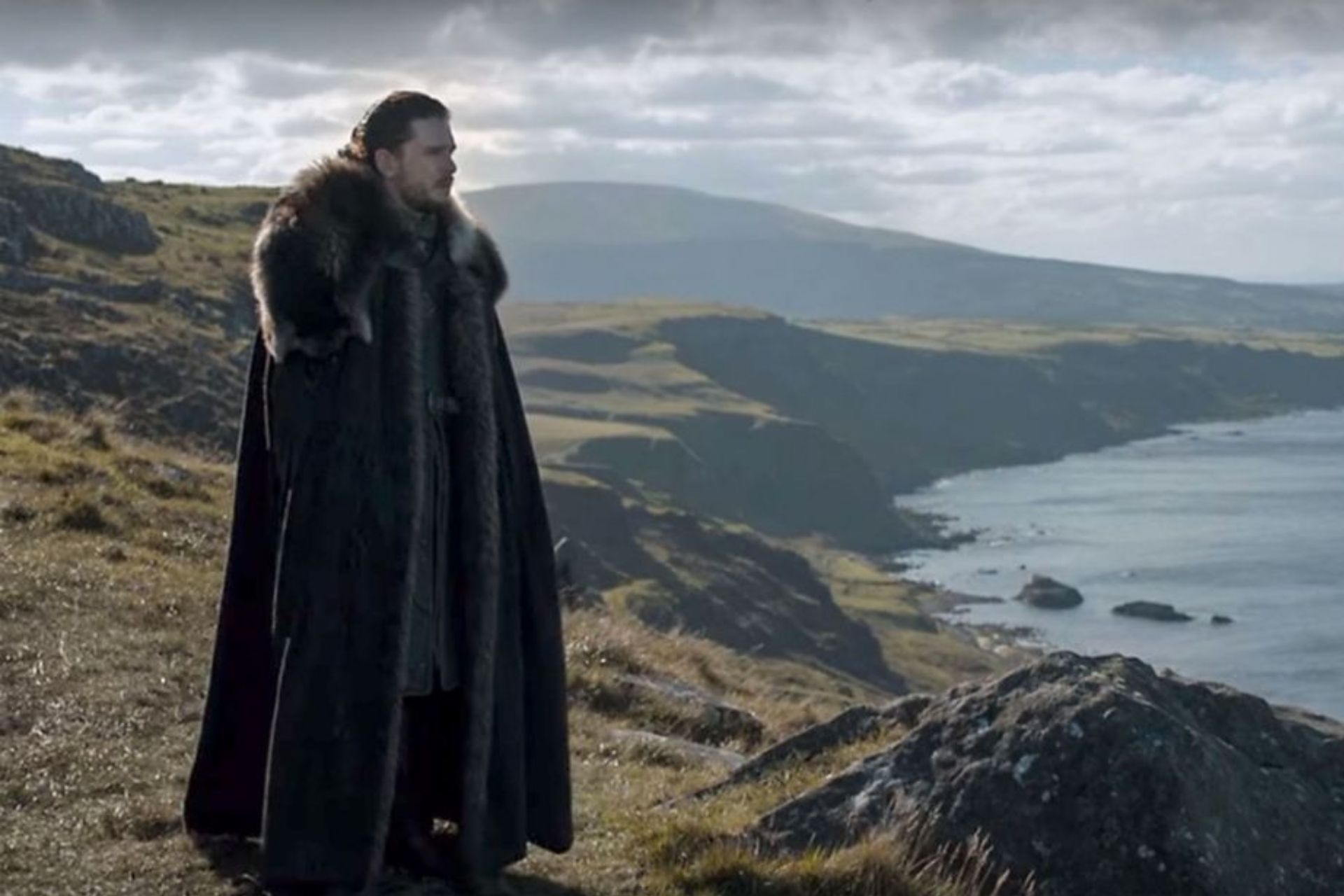
Credit: HBO
Fair Head, located in Northern Ireland, became Dragonstone in Game of Thrones. Jon Snow met Daenerys and her dragons here. The cliffs stand 200 meters (660 feet) tall and stretch for 5 kilometers (3.1 miles) along the northeastern coast of County Antrim.
The cliff face is made of dolerite rock, shaped like giant organ pipes. These unique rock formations formed 60 million years ago when molten rock pushed through layers of sediment. The striking vertical columns create a dramatic landscape, perfect for the show’s powerful scenes.
Fair Head is also one of the top climbing spots in the British Isles. Its sheer walls attract climbers from all over. The cliff offers many challenging routes, with some reaching the extreme E9 grade. Climbers can find both traditional climbs and bouldering problems here, including famous routes like Rathlin Effect and Long Runs the Fox. It is also known for high-level bouldering problems, with grades reaching up to 8B+ (V14), such as the challenging Blondie SDS.
3. Saintfield, Co. Down: Battle of the Bastards / Battle of Winterfell
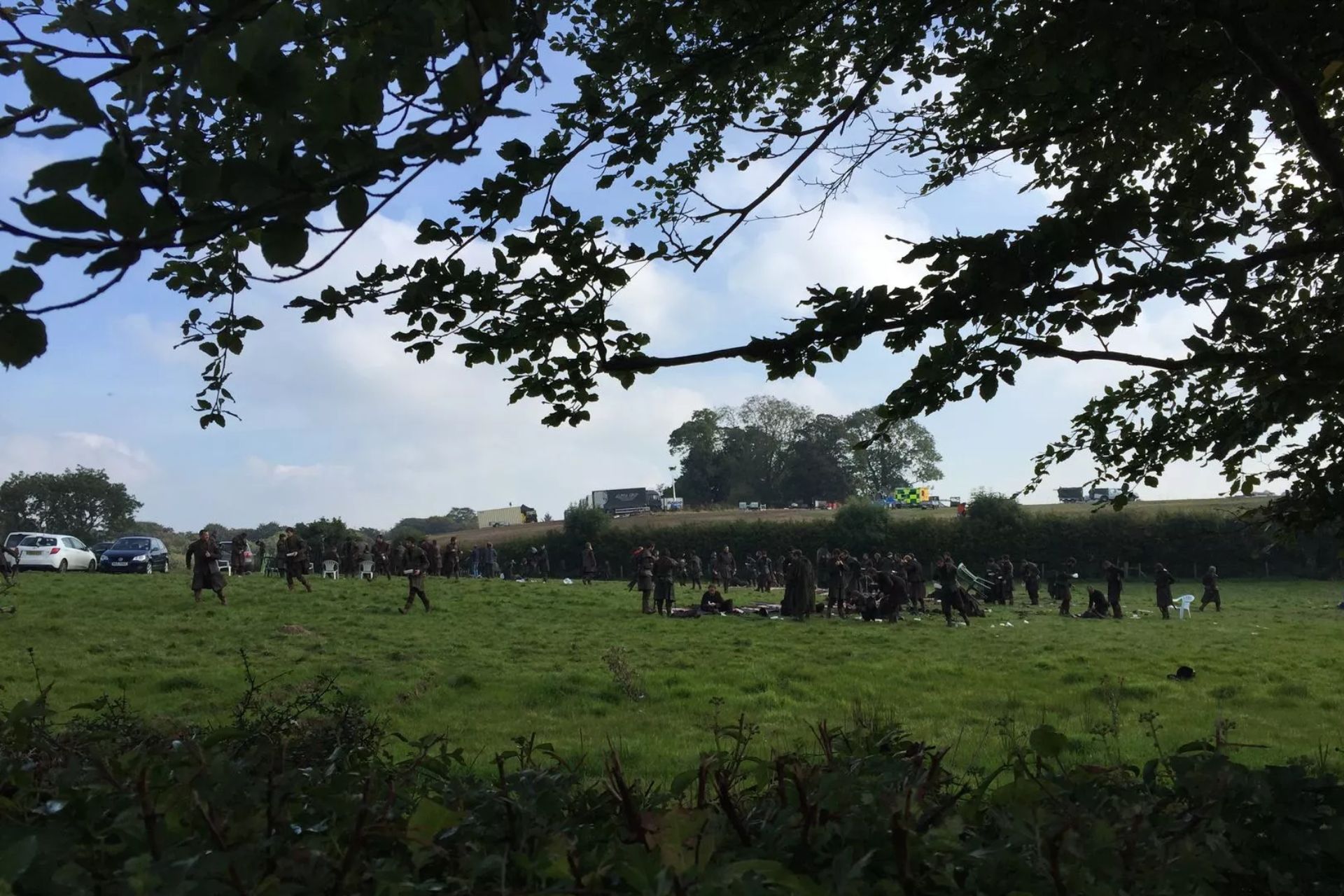
Credit: Belfast Live
In the peaceful village of Saintfield, Northern Ireland, two famous Game of Thrones battle scenes came to life. The lush green fields here became the battlegrounds for the Battle of the Bastards and the Battle of Winterfell. With a bit of imagination and the help of CGI, these quiet fields transformed into epic war zones filled with giants and White Walkers.
Saintfield, meaning “Field of Saints” in Irish, is a small village in County Down. It sits halfway between Belfast and Downpatrick, along the A7 road. The village had a population of 3,588 in the 2021 Census, mainly made up of commuters working in Belfast, just 18 kilometers away. The surrounding countryside remains rooted in farming, contributing to the area’s serene atmosphere.
Saintfield’s layout is simple. The A7 road runs through it from east to west. The B6 road crosses it, with Main Street leading west toward Lisburn and Ballynahinch. Station Road heads east toward Killyleagh.
While Saintfield’s fields may appear quiet now, for Game of Thrones fans, they hold the memory of epic battles fought on screen, adding a sense of cinematic history to the village’s calm surroundings.
4. Sallagh Braes, Antrim: The Riverlands
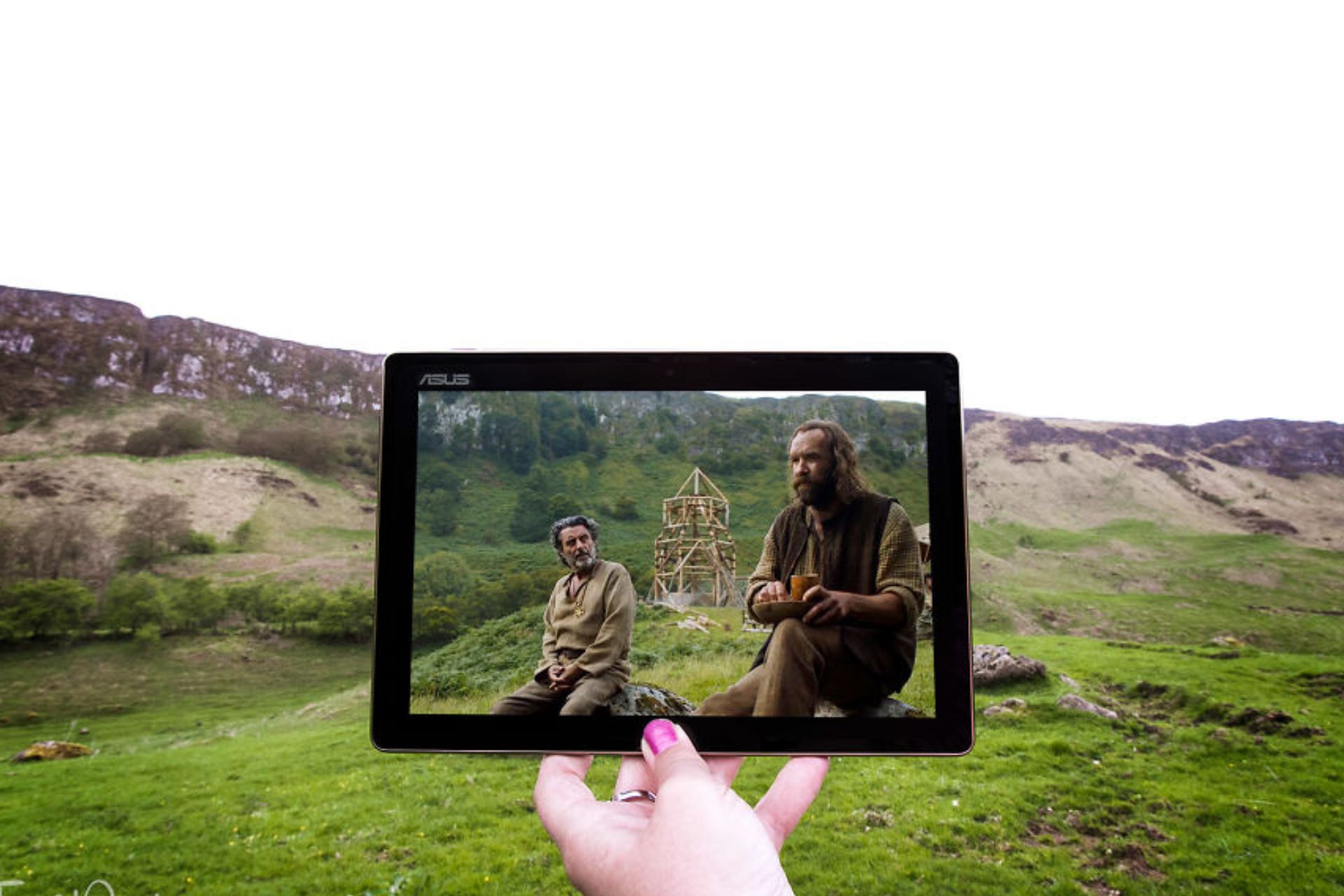
Credit: Fangirl Quest
You might recognize Sallagh Braes from season 6, episode 7 of Game of Thrones. In “The Broken Man,” the Hound recovers here after Brienne of Tarth and Arya Stark brutally beat and stabbed him. This dramatic location is part of the Antrim Coast and Glens Area of Outstanding Natural Beauty.
The trail along the Sallagh Braes cliffs offers stunning views. As you walk along the cliff’s edge, you’ll enjoy sweeping views of Ballygally Head and the distant Irish Sea. The landscape is breathtaking and rich with history. It is near Linford Barrows, which has two ancient mounds dating back to the Bronze Age.
This area is a popular filming spot, and Game of Thrones is just one of the many shows that have been shot here. The stunning cliffs and open views make it an unforgettable location.
5. Shillanavoghy Valley, Antrim : Dothraki Sea
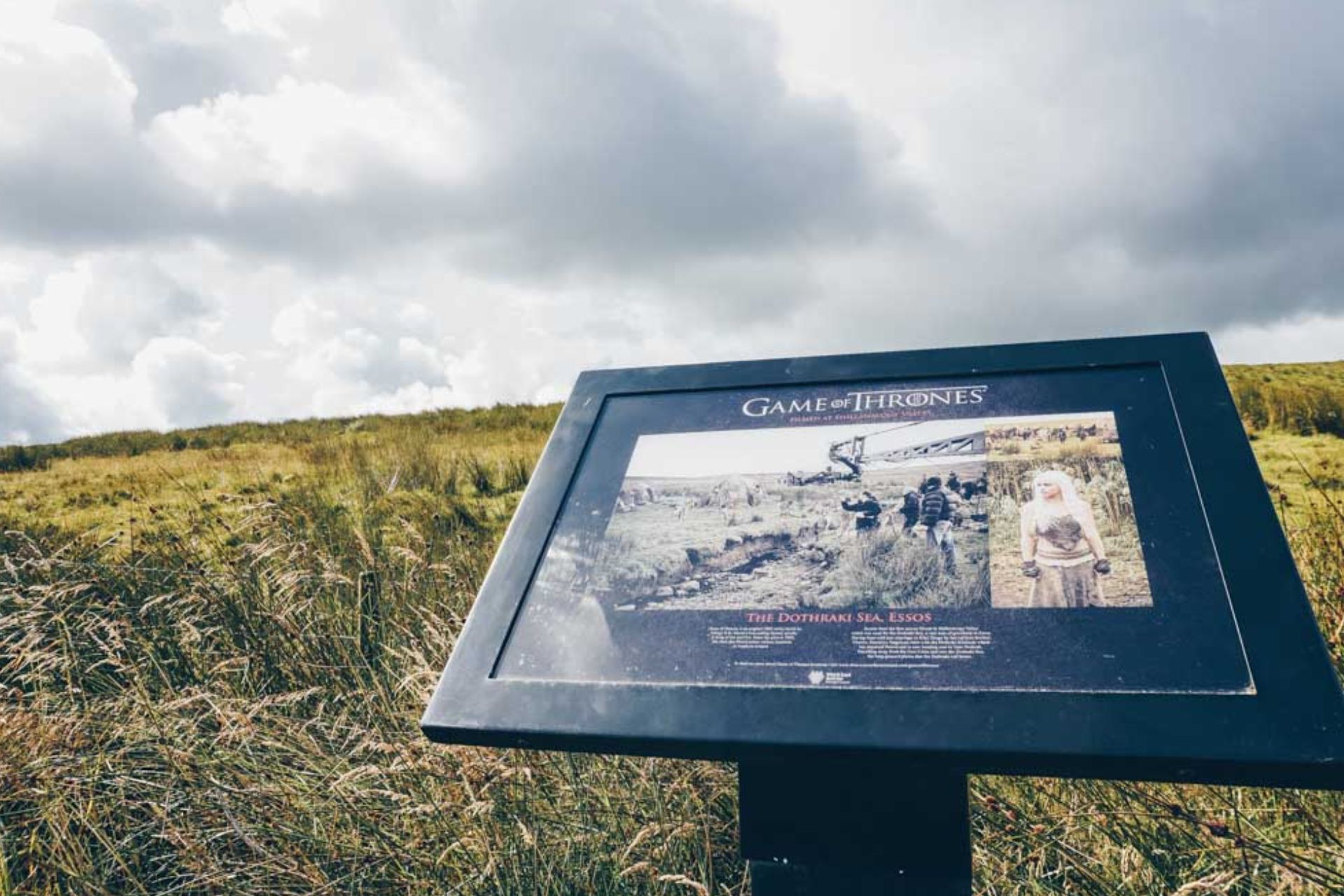
Credit: Thediscoveriesof.com
Beneath Slemish Mountain, Game of Thrones filmed scenes of the Khalasar departing Pentos and riding to Vaes Dothrak. This valley lies just east of Ballymena, in County Antrim. The mountain is famous in Irish history as the place where St. Patrick, Ireland’s patron saint, tended sheep after pirates captured him and killed his family.
Slemish Mountain is the core of an extinct volcano. It sits within an Environmentally Sensitive Area (ESA), making it a protected natural spot. Bird watchers flock here to see large black ravens, buzzards, wheatears, and meadow pipits, which are often spotted in the area.
The valley beneath Slemish offers beautiful views and a connection to both nature and history. Whether you’re a fan of Game of Thrones, a bird enthusiast, or simply love hiking, Slemish Mountain is worth a visit.
6. Ballintoy Harbour, Causeway Coast: The Iron Islands
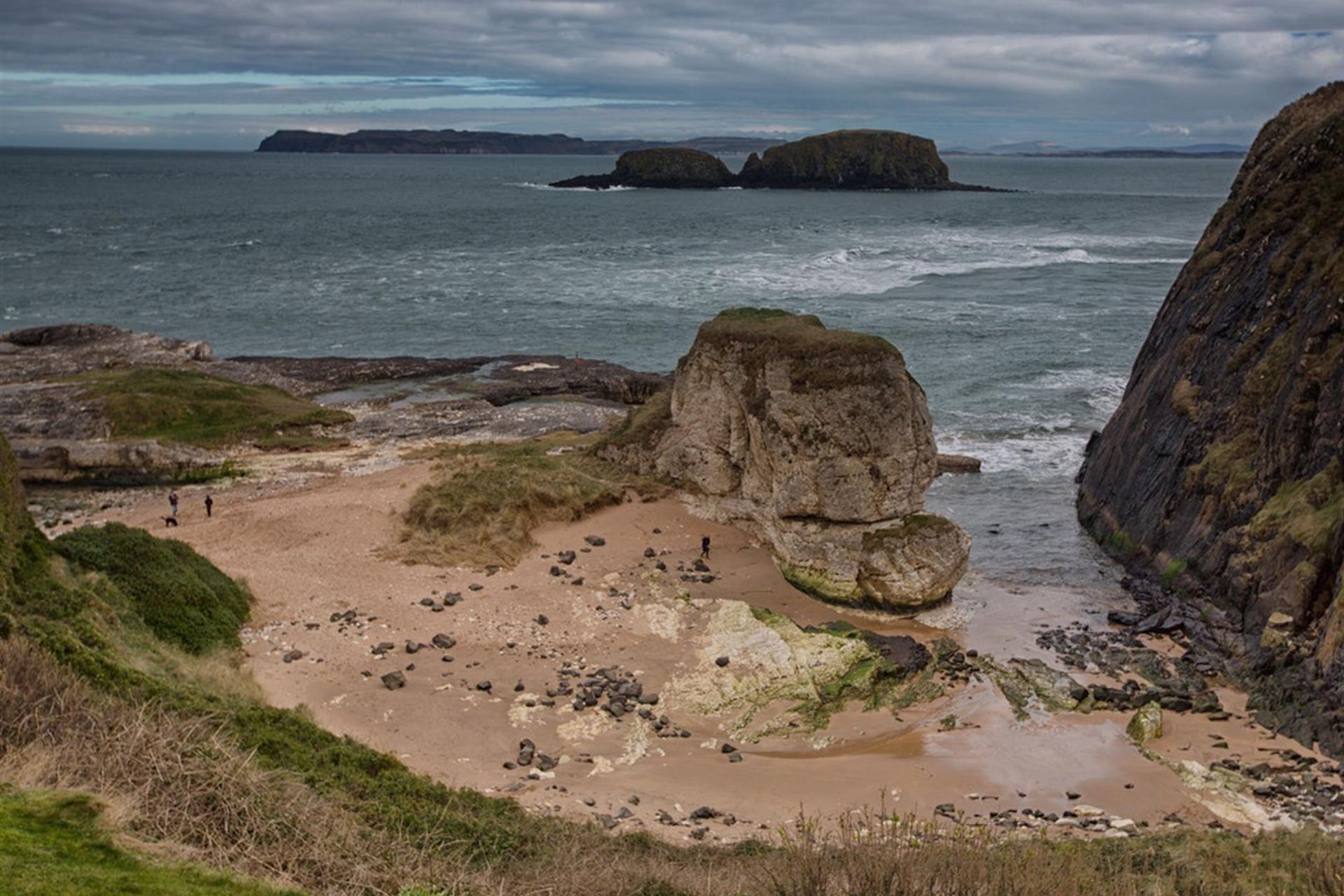
Credit: Discover Northern Ireland
Ballintoy Harbour was used for exterior shots of Pyke and the Iron Islands. In Season 2, Episode 2, Theon arrives here, admires his ship, the Sea Bitch, and meets Yara. In Episode 3, he is baptized. Season 6, Episode 5, features Euron Greyjoy’s drowning and rebirth at the harbor. Nearby, Melisandre burns Stannis Baratheon’s bannerman on the beach. The harbor also serves as the Free Cities, where Varys was born.
Situated between the Giant’s Causeway and Ballycastle, Ballintoy is known for its scenic beauty. Visitors reach it by a steep, winding road, offering breathtaking views. The area is a painter’s paradise with sea stacks, rocky islands, pools, and a busy harbor. It also connects to some of Europe’s best cliff-top and wild beach walks.
Ballintoy village, just a kilometer from the harbor, features small shops, two churches, including the quaint white Ballintoy Parish Church overlooking the harbor, and various tourist accommodations and restaurants. It is a charming stop for those seeking a taste of Irish rural life while touring the coast.
7. Tollymore Forest, Newcastle: The North
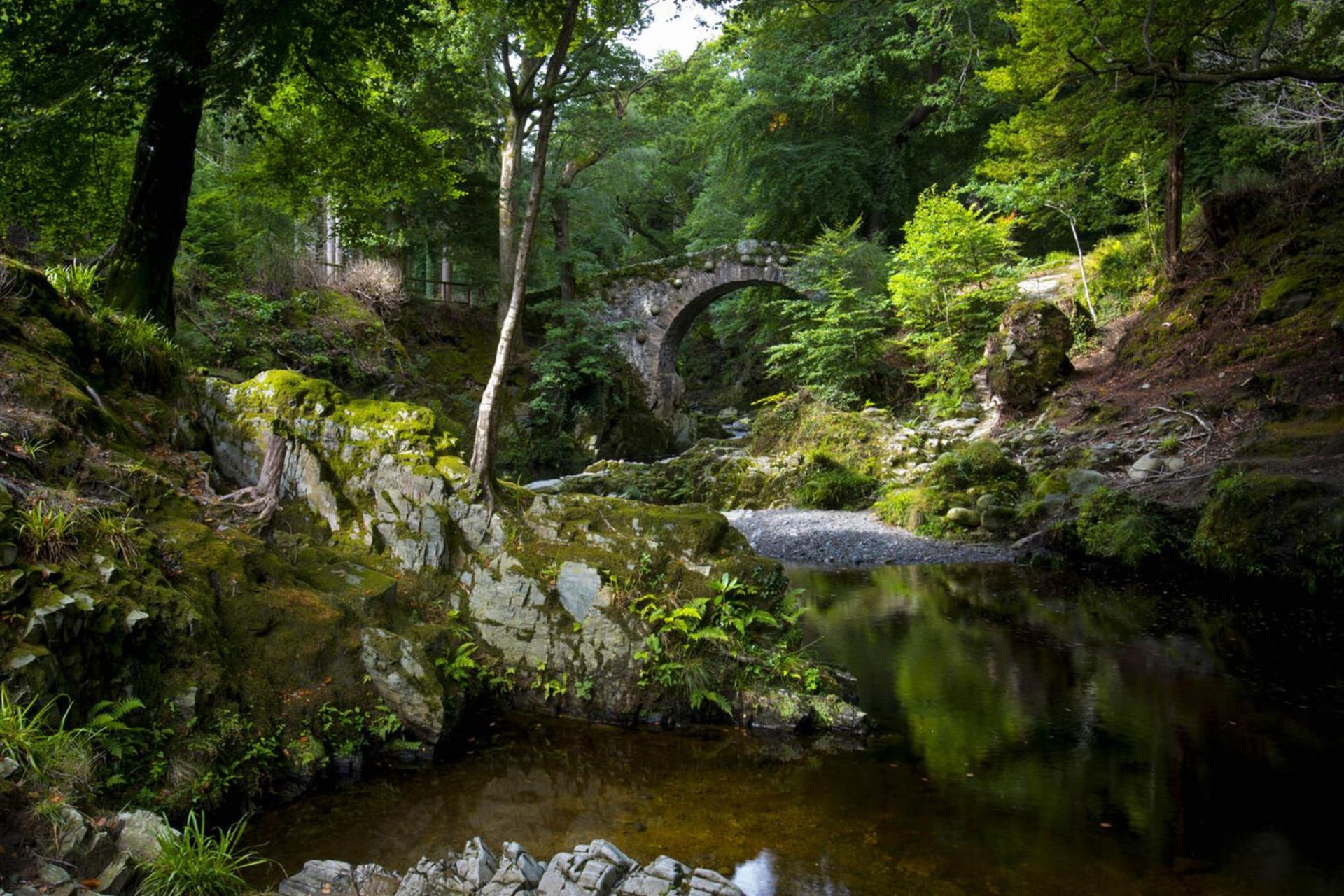
Credit: Discover Northern Ireland
In Game of Thrones Season 1, Tollymore Forest Park doubled as the Haunted Forest. Fans will remember it as the place where the Nightwalkers first appeared and where the Stark kids found the direwolf pups. Many woodland and snowy forest scenes were filmed here. Nearby, at Leitrim Lodge, Bran and Rickon Stark planned their escape from Theon Greyjoy.
Tollymore Forest Park, located at the foot of the Mourne Mountains, covers almost 630 hectares. It offers panoramic views of the surrounding mountains and the sea at Newcastle. Open year-round, it’s a popular spot for nature lovers and hikers.
The park is full of unique sights. Designed by Thomas Wright in the 18th century, you’ll find quirky structures like a barn that looks like a church, stone cones on gate piers, and gothic-style arches. Lord Clanbrassil, the park’s owner at the time, loved these unusual features.
A walk along the Shimna River reveals many curiosities, both natural and man-made. You’ll pass rocky outcrops, bridges, grottos, and caves. The park also has experimental forest plots with exotic trees like monkey puzzles and eucalyptus. You’ll see giant redwoods, Monterey pines, and even the famous oak wood used to build the interiors of the Titanic in Belfast.
Look for the slow-growing spruce, Picea abies ‘Clanbrassiliana,’ which dates back to 1750 and is the oldest tree in any Irish arboretum. The park’s entrance features a grand avenue lined with Deodar cedars, adding to its romantic charm.
8. The Dark Hedges, Ballymoney: Kingsroad
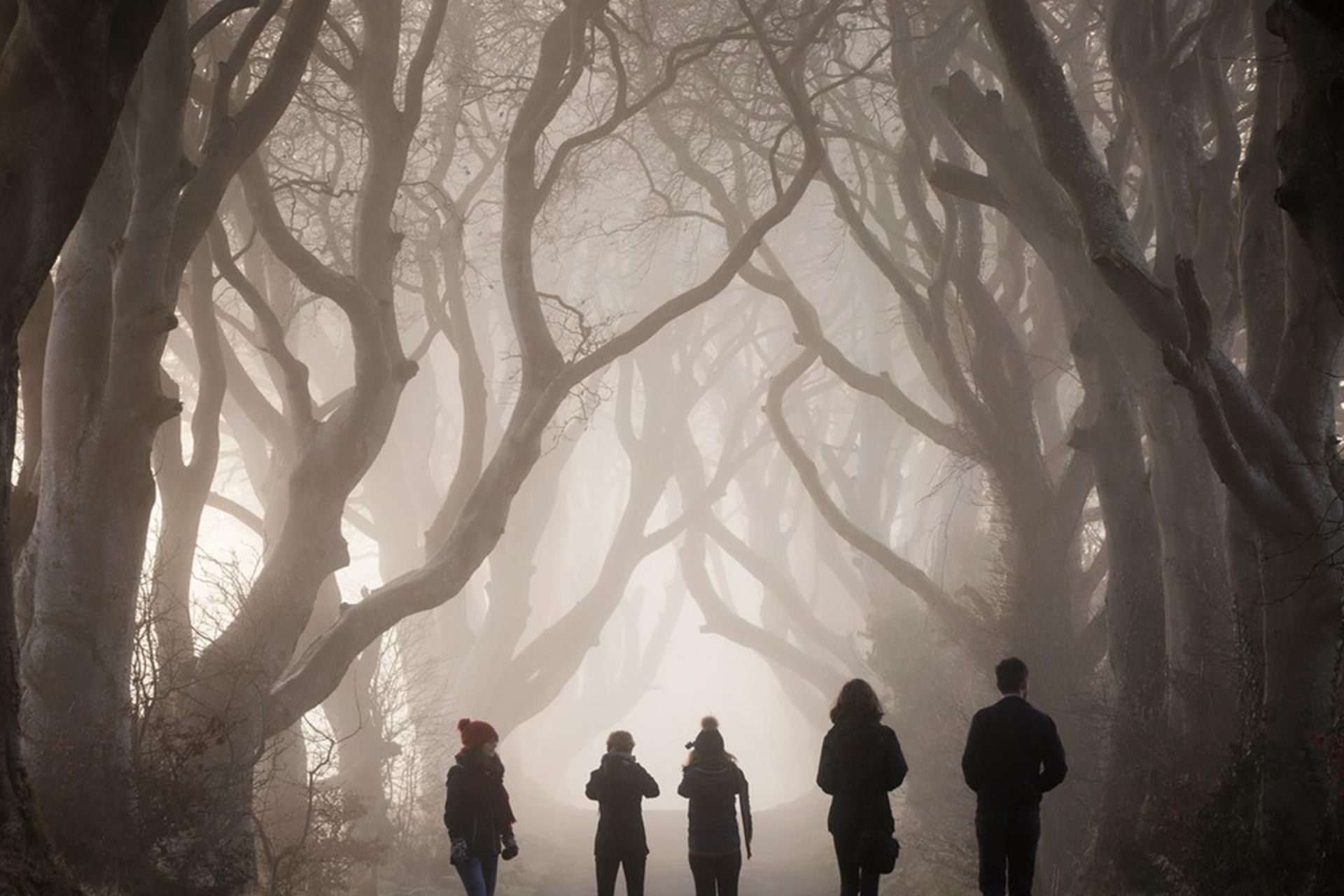
Credit: Discover Northern Ireland
The Dark Hedges, a famous avenue of beech trees in County Antrim, Northern Ireland, has been a popular tourist attraction long before Game of Thrones. It is shown as the grandest highway in Westeros, the Kingsroad, stretching from Castle Black to King’s Landing.
Located on Bregagh Road between Armoy and Stranocum, the trees create a stunning tunnel that draws visitors from all over the world. The atmospheric avenue gained even more attention after it was used as a filming location for Game of Thrones, making it a must-see spot for fans.
The Dark Hedges has a rich history. In 1775, James Stuart planted over 150 beech trees along the road leading to his home, Gracehill House, named after his wife Grace Lynd. His goal was to create a grand and impressive entrance to the estate, and over the centuries, the trees have grown into the hauntingly beautiful landmark we see today.
The avenue also has a legendary ghost story. Locals say the “Grey Lady” haunts the Dark Hedges, drifting between the trees. Some claim she is the spirit of James Stuart’s daughter, known as Cross Peggy. Others say she was a maid who died mysteriously or a spirit from an old graveyard nearby. On Halloween, it is said that other spirits join her on her eerie journey along the road.
9. Murlough Bay, Antrim: Slavers’ Bay
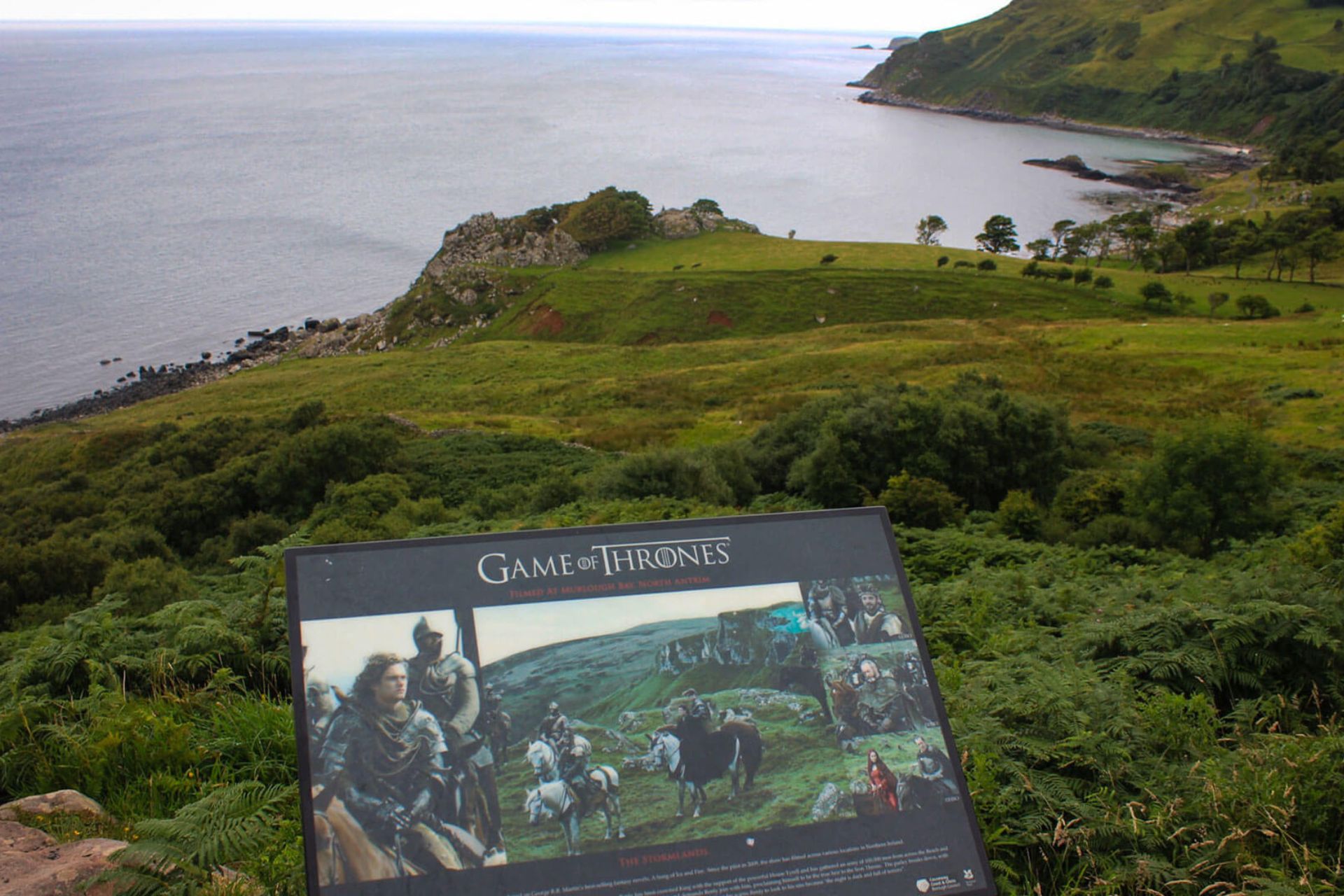
Credit: Abhainn Cruises
Murlough Bay, on the north coast of County Antrim, Northern Ireland, is a place of stunning beauty. It lies between Fair Head and Torr Head, offering views of Rathlin Island and the Scottish isles like Mull of Kintyre and Islay. Known for its basalt cliffs and sandstone layers, the area has a rich history and geology, including old lime kilns.
In Game of Thrones, Murlough Bay appears as Slavers’ Bay. It is where Davos Seaworth is shipwrecked after the Battle of Blackwater Bay and where Tyrion and Jorah are captured by slavers. The rugged landscape makes it a perfect filming location for these intense scenes. It is also the site where Renly and Stannis parley.
Murlough Bay also holds historical significance. According to legend, Saint Columba landed here in 595 AD when he sailed from Iona to attend the Synod of Drumceat. The bay has long been a special place in Irish history.
It is also linked to Irish revolutionary leader Roger Casement. Once a British diplomat, Casement was executed for treason during World War I. Before his death, he requested to be buried at Murlough Bay, a place he loved. Although he is now buried in Dublin, a cross was erected in his honor at Murlough. Every August, a small memorial takes place here to remember him.
10. Quintin Bay, Portaferry: Stokeworth
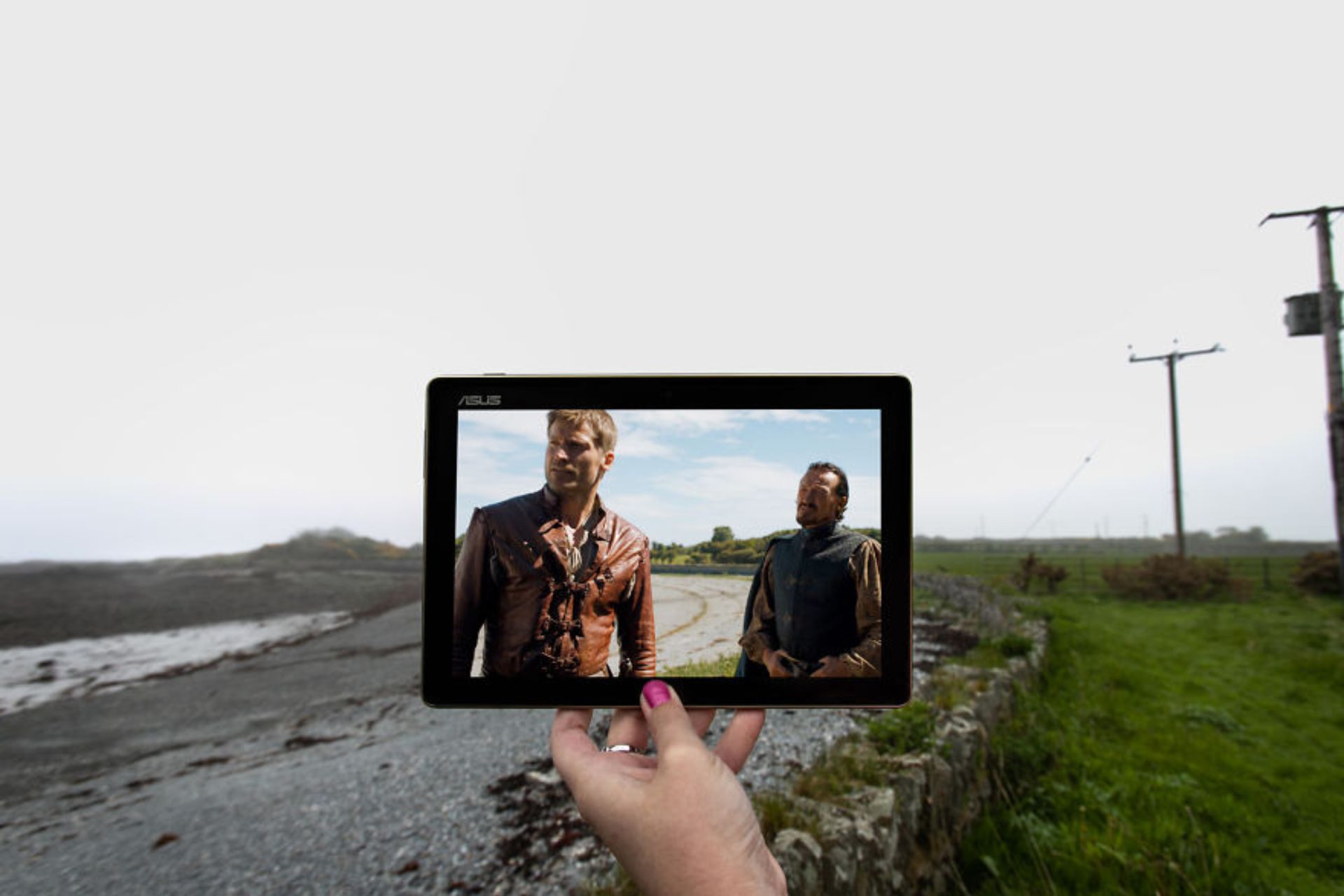
Credit: Fangirl Quest
In Game of Thrones, Jamie Lannister tracks down Bronn at Stokeworth to ask him to travel to Dorne. This forgotten filming location is near Quintin Castle, a historic site in County Down, Northern Ireland.
Quintin Castle sits about 4 kilometers east of Portaferry. The Montgomery family originally owned the castle.
In the early 19th century, Elizabeth Calvert, a descendant of Ross, inherited the castle. She restored it in 1850, bringing it back to life. Over the years, the castle changed hands.
The castle was converted into an 8-bedroom private venue. Today, it serves as a stunning location for weddings, conferences, and events.
11. Mageramorne Quarry, Antrim: Castle Black and Hardhome
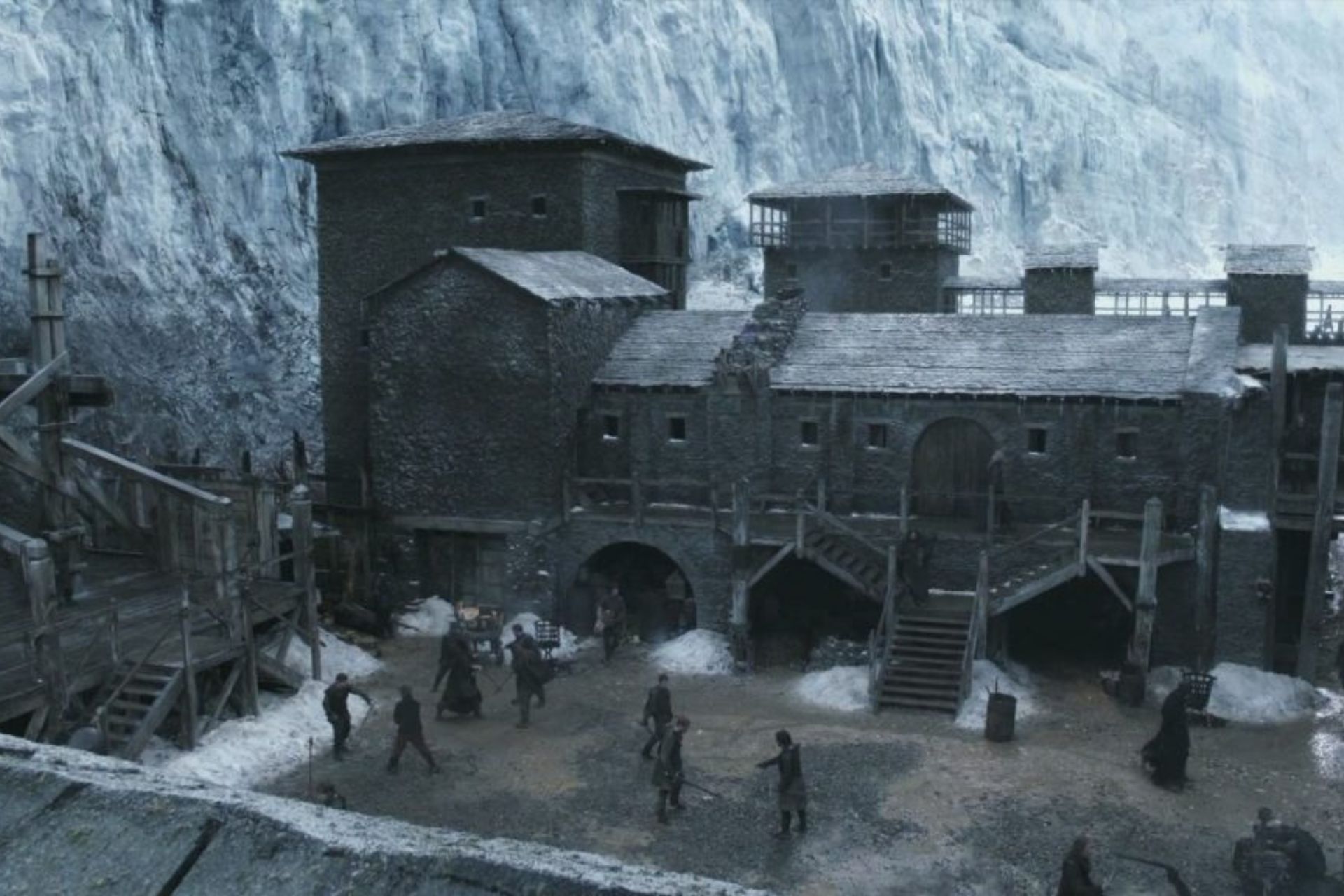
Credit: Thelocationguide.com
Magheramorne, a small hamlet in County Antrim, Northern Ireland, served as a key filming location for *Game of Thrones*. This area became the backdrop for Castle Black, Hardhome, and parts of King’s Landing. The towering ice wall and snowy landscapes were created digitally, but the natural stone walls of an old limestone quarry formed the base for the scenes. A functional elevator was built to lift rangers to the top of the wall, with CGI making it appear even taller.
Magheramorne lies about 5 miles south of Larne, along the shores of Larne Lough. The quarry, once bustling with limestone extraction for a nearby cement plant, became desolate after operations ceased in 1980. In the 19th century, a Presbyterian church was built for the laborers working at the limeworks.
Lafarge, the company that owns the quarry, received permission in 2009 to redevelop the area. Plans included an eco-friendly village, a World Cycling Centre, and a scuba diving hub. However, the project remains uncertain.
Today, the area near the quarry is largely abandoned and off-limits to the public. The factory site is crumbling, with remnants of its industrial past still visible. Despite its desolation, Magheramorne gained new fame through its role in *Game of Thrones*, where it transformed into a gritty, cold, and remote location fitting for the end of the world.
George R. R. Martin himself visited the site, noting how the wet, rainy conditions helped immerse the actors in the harsh world of Westeros.
12. Binevenagh, Limavady: Dothraki Grasslands
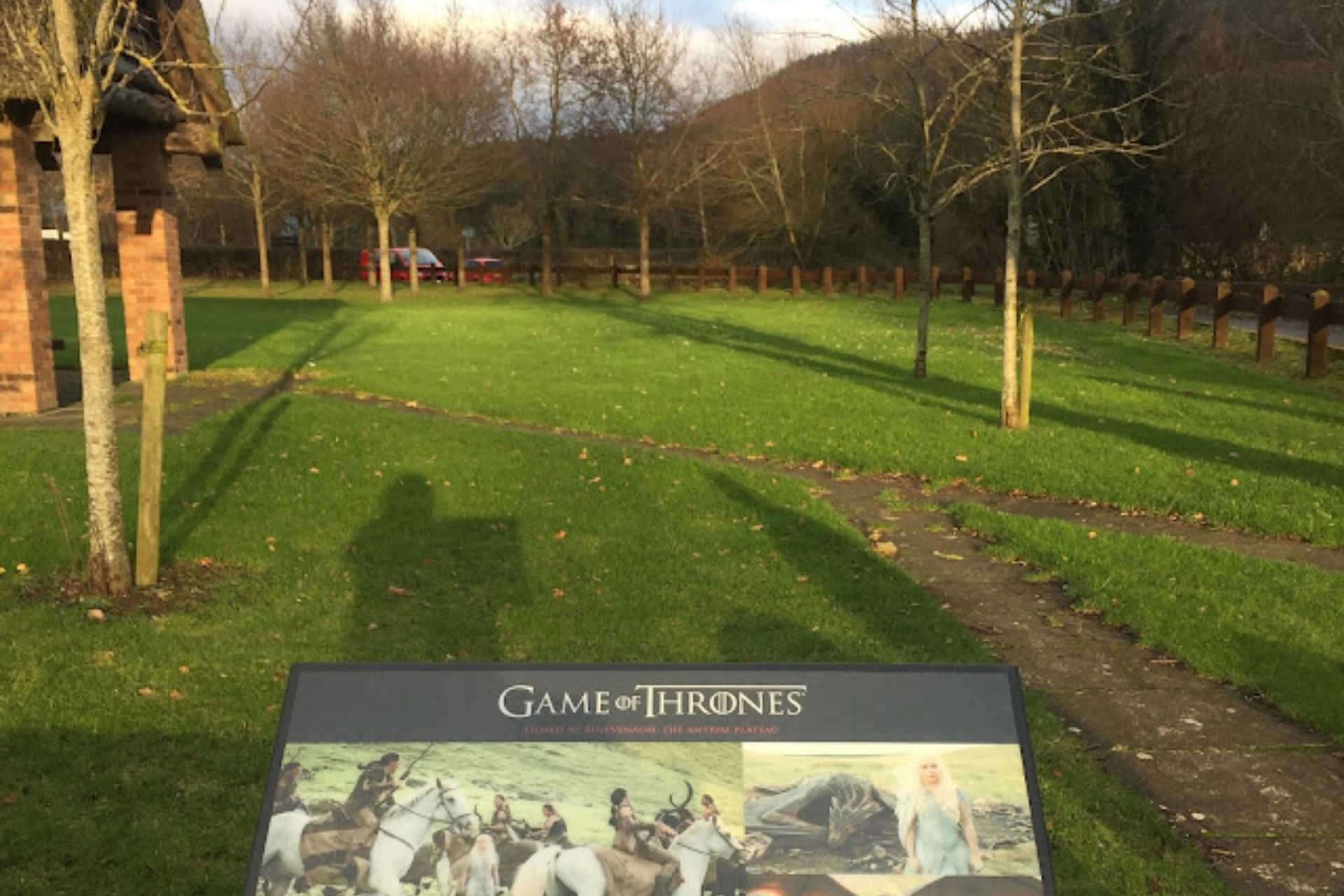
Credit: Bow Dream Nation
In season five of Game of Thrones, Daenerys meets a horde of house warriors at this stunning location. The vast landscape and towering cliffs provide a dramatic backdrop. Binevenagh, meaning “Foibhne’s peak” in Irish, is a steep hill in County Londonderry, Northern Ireland. It is part of the Keenaght Hills, which form the western edge of the Antrim Plateau. These hills were created about 60 million years ago by molten lava. Binevenagh overlooks the Magilligan peninsula and towers over villages like Bellarena, Downhill, and Castlerock, as well as Benone beach.
The area has been recognized as an Area of Special Scientific Interest and an Area of Outstanding Natural Beauty (AONB), covering 138 square kilometers. The Bishop’s Road, named after the Bishop of Derry, runs across the plateau. Key features include the Mussenden Temple and a cliff-top viewing area offering spectacular views over Lough Foyle and across Inishowen in County Donegal.
Binevenagh is also a hub for outdoor sports. The Ulster Gliding Club uses the slopes for gliding, while the Ulster Hang Gliding and Paragliding Club enjoys the area for soaring. There is an artificial lake at the top of the mountain used for trout fishing. Additionally, the Coleraine & District Motor Club hosts the Eagles Rock hillclimbing event here every July.
13. Inch Abbey, Downpatrick: Riverlands
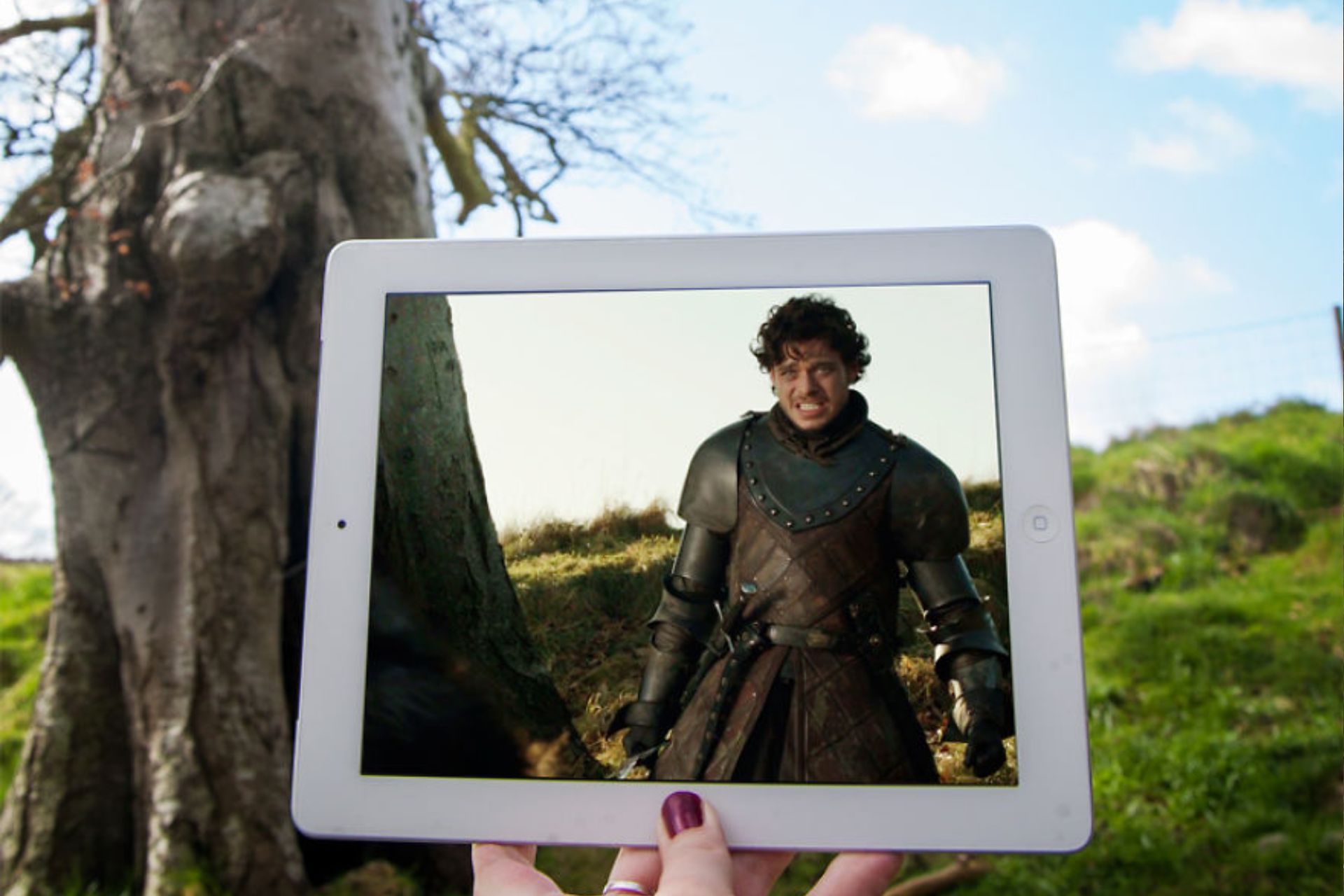
Credit: Fangirl Quest
Robb Stark’s army camped here while waiting to cross the Trident. After the battle in the Whispering Wood, this is where his men crowned him “King in the North.” Inch Abbey, located on the outskirts of Downpatrick in County Down, Northern Ireland, is a ruined Cistercian monastery.
The Anglo-Norman knight John de Courcy founded the monastery in the 12th century. He built it as penance for destroying Erenagh Abbey in 1177. Before Inch Abbey, a monastery stood here from the 9th century until the early 12th century.
The name “Inch” comes from the Irish word “inis,” meaning “island.” Originally, the monastery was surrounded by the River Quoile, giving it an island-like appearance.
Inch Abbey is accessible by train through Inch Abbey railway station, operated by the Downpatrick and County Down Railway.
14. Cushendun Caves, Antrim: The Stormlands
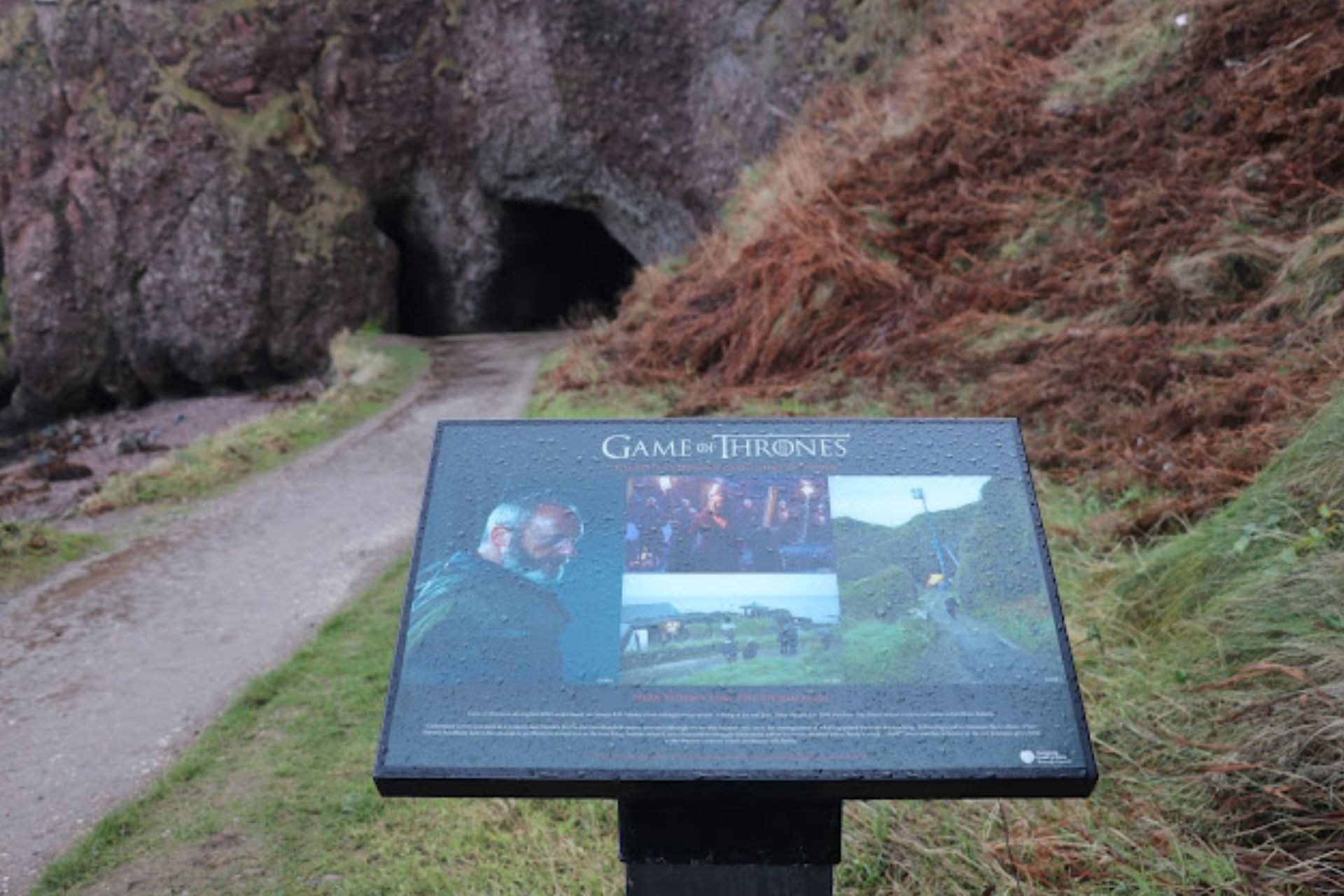
Credit: Bow Dream Nation
Fans will recognize these caves from the scene where the Red Priestess Melisandre gives birth to the shadow creature that kills Renly Baratheon.
Cushendun, a small coastal village in County Antrim, Northern Ireland, sits off the A2 coast road between Cushendall and Ballycastle. It has a sheltered harbor and lies at the mouth of the River Dun and Glendun. On clear days, you can see the Mull of Kintyre in Scotland, which is about 15 miles away.
The village was designed in the style of a Cornish village by architect Clough Williams-Ellis. The National Trust has owned and maintained much of the village and parkland around Glenmona House since 1954.
Cushendun became a conservation area in 1980 due to its architectural significance and its location in the Antrim Coast and Glens Area of Outstanding Natural Beauty.
15. Downhill Strand, Castlerock: Dragonstone
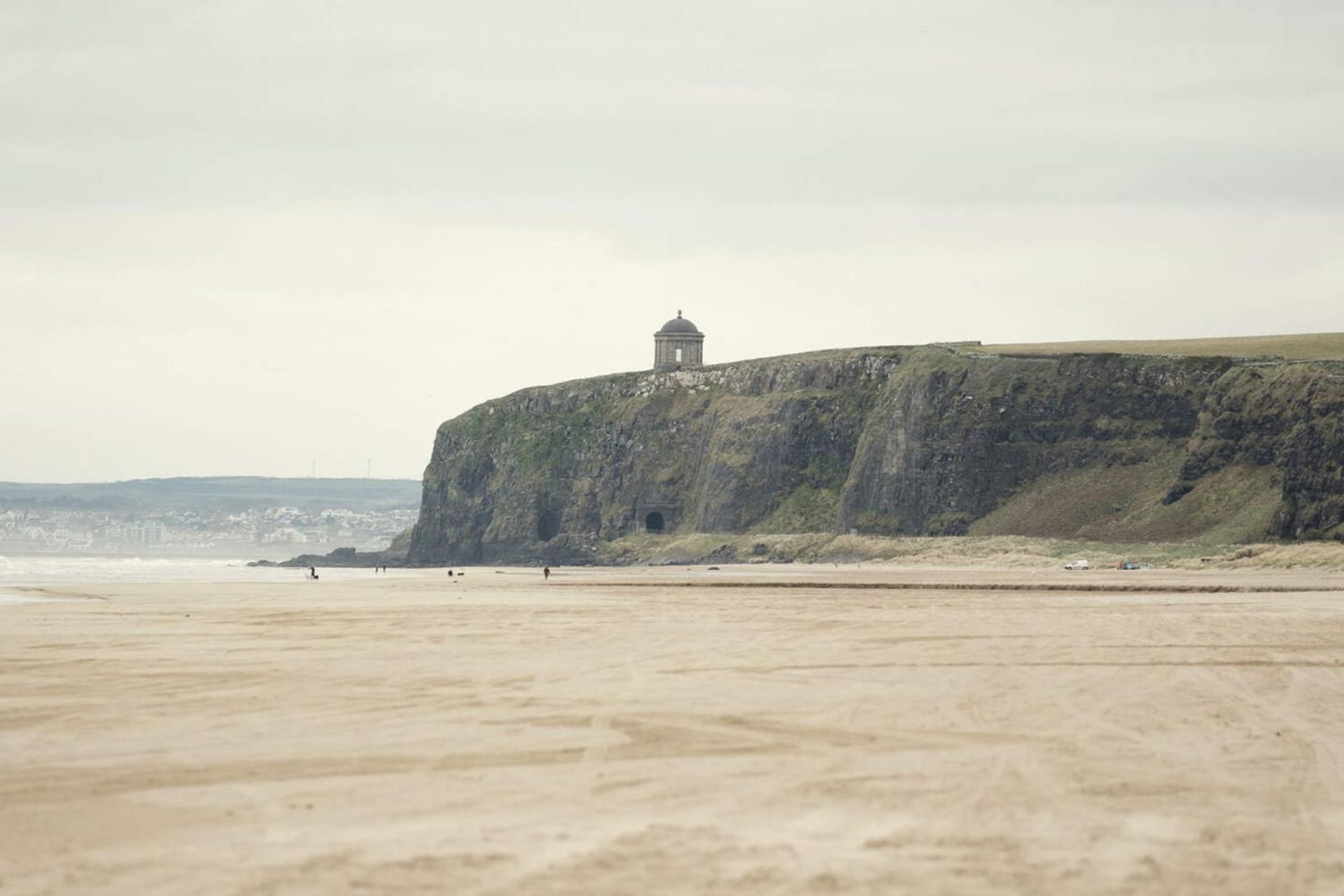
Credit: Discover Northern Ireland
Downhill Beach served as the setting for Dragonstone in Game of Thrones, where Lady Melisandre made her sacrifices to the Lord of Light.
This 7-mile stretch of sand offers activities like water sports and scenic walks. It frequently earns the Blue Flag Award and allows cars year-round.
Downhill Beach, along with nearby Benone and Magilligan beaches, is an Area of Special Scientific Interest (ASSI) and a Special Area of Conservation (SAC).
The area features beautiful sand dunes, birdlife, cascading waterfalls, and Mussenden Temple. The Temple, a popular photography spot, offers stunning views of the North Coast and nearby counties.
Downhill Beach is near Castlerock, a small town with accommodation, pubs, restaurants, and transport links.
16. Glenariff, Antrim: Runestone
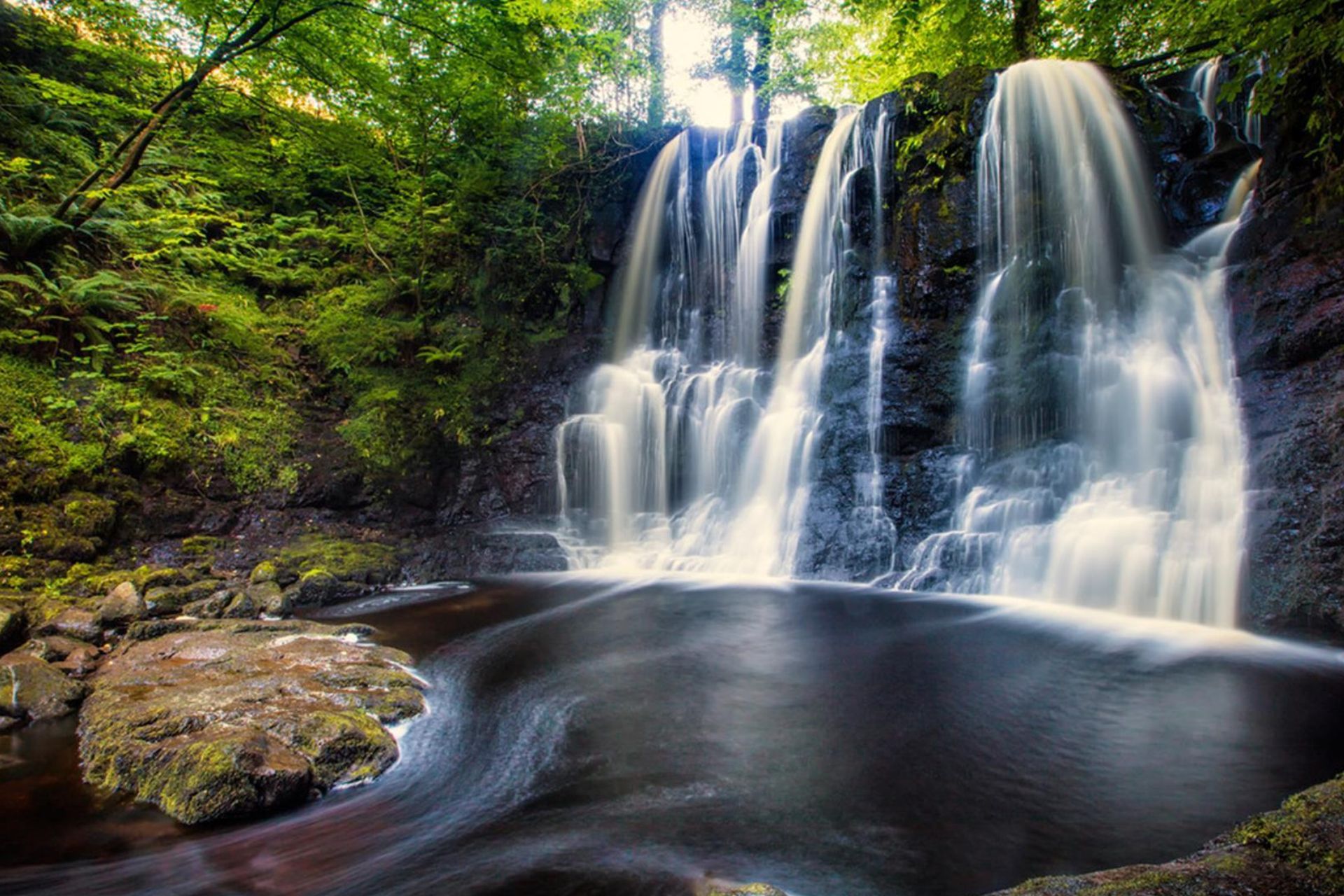
Credit: Discover Northern Ireland
Littlefinger travels through Glenariff with Sansa to meet Lord Royce and see Robin Arryn train in The Vale. Glenariff, or Glenariffe, is a valley in County Antrim, Northern Ireland. It is one of the Glens of Antrim, shaped by glaciers during the Ice Age.
Known as the ‘Queen of the Glens,’ it is the largest and most visited of the Glens of Antrim. The village of Waterfoot sits at the foot of the glen, along the coast.
Glenariff Forest Park is a popular spot, featuring trails through the trees and beside waterfalls.
17. Cairncastle, Ballygally: The North
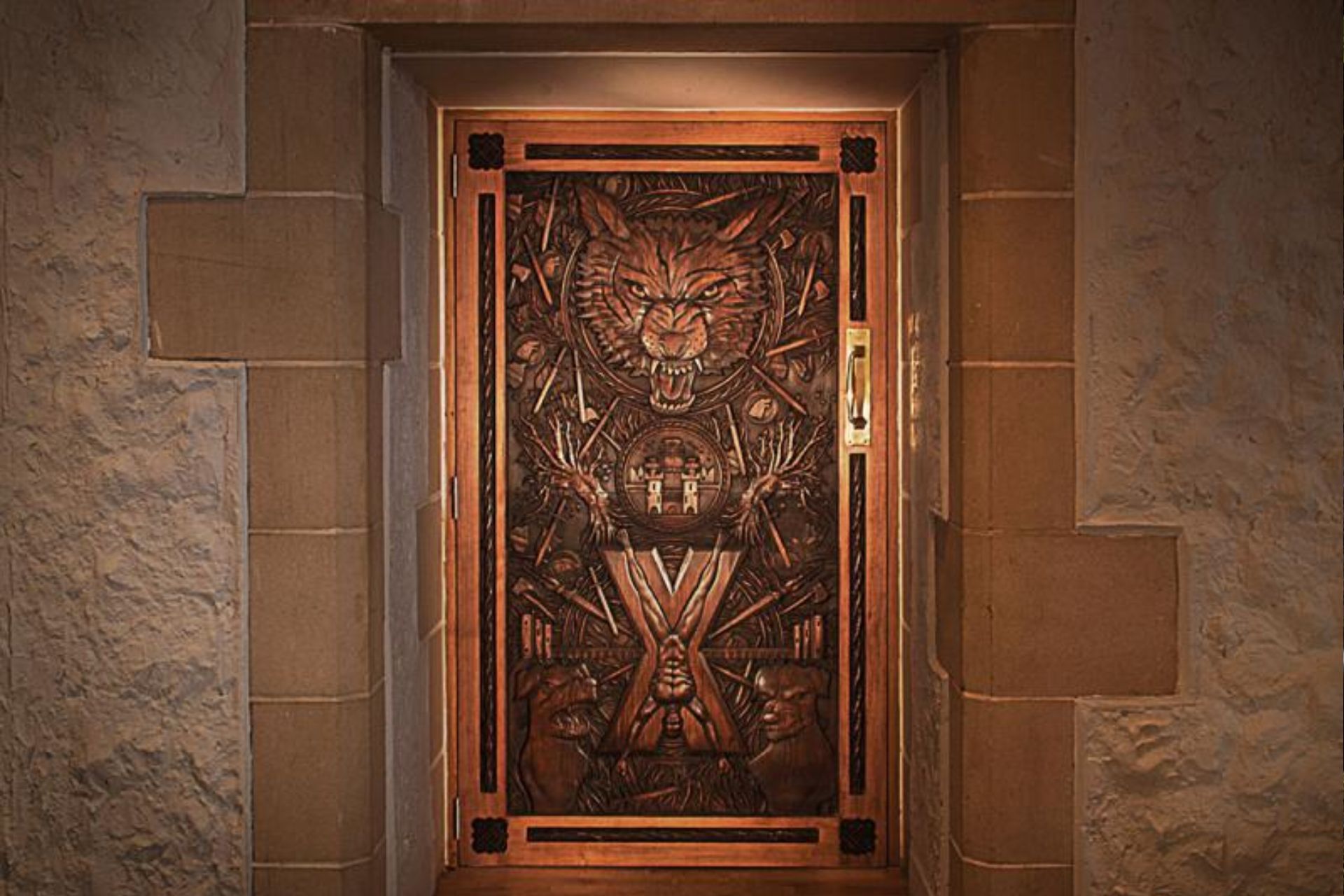
Credit: hastingshotels.com
Cairncastle appears in several scenes in *Game of Thrones*. In Season 1, Ned Stark beheads a deserter from the Night’s Watch here. The crew returned in Season 3 when Jaime Lannister was released from captivity and traveling back to King’s Landing. Baelish also journeys through Cairncastle with Sansa on their way to meet Ramsay Bolton. Cairncastle, or Carincastle, is a small village in County Antrim, Northern Ireland, near Larne. It had a population of 66 in the 2001 Census and is part of the Mid and East Antrim Borough Council area.
Cairncastle has one of the oldest Presbyterian churches in Ireland, founded in 1646. The churchyard contains a Spanish chestnut tree, known as the “Spanish Armada Tree,” which local legend claims sprouted from a seed carried by a sailor from the Spanish Armada.
Knockdhu, meaning ‘black hill,’ is a Bronze Age promontory fort located about a mile west of Cairncastle. It features banks, ditches, roundhouses, and a possible gatehouse.
18. Quoile River, Downpatrick: Riverrun
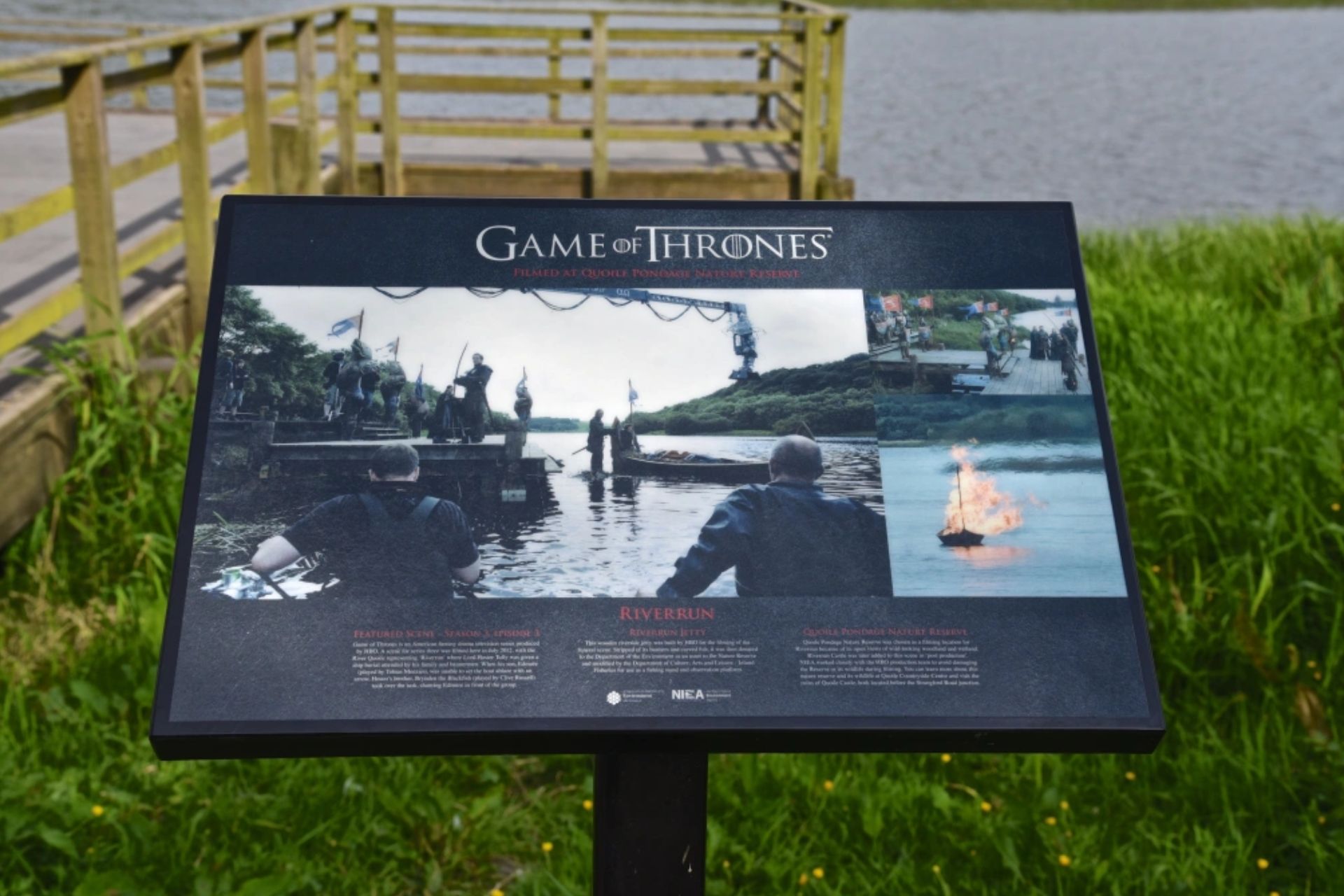
Credit: Townlands of Ulster
The Riverlands, where the Tullys live, feature the River Quoile, which was used for Hoster Tully’s funeral scenes.
The river starts as the Ballynahinch River, flowing from west of Ballynahinch to Annacloy, where it becomes the Annacloy River. It then becomes the Quoile and flows through Downpatrick and the Quoile Pondage before emptying into Strangford Lough.
Quoile Castle, a 16th-century tower house, stands 1.5 miles (2.4 km) from Downpatrick. It sits off the main road from Downpatrick to Strangford, on the east bank of the river. The castle was inhabited until the 18th century.
19. Portstewart Strand, North Coast: Dorne Coast
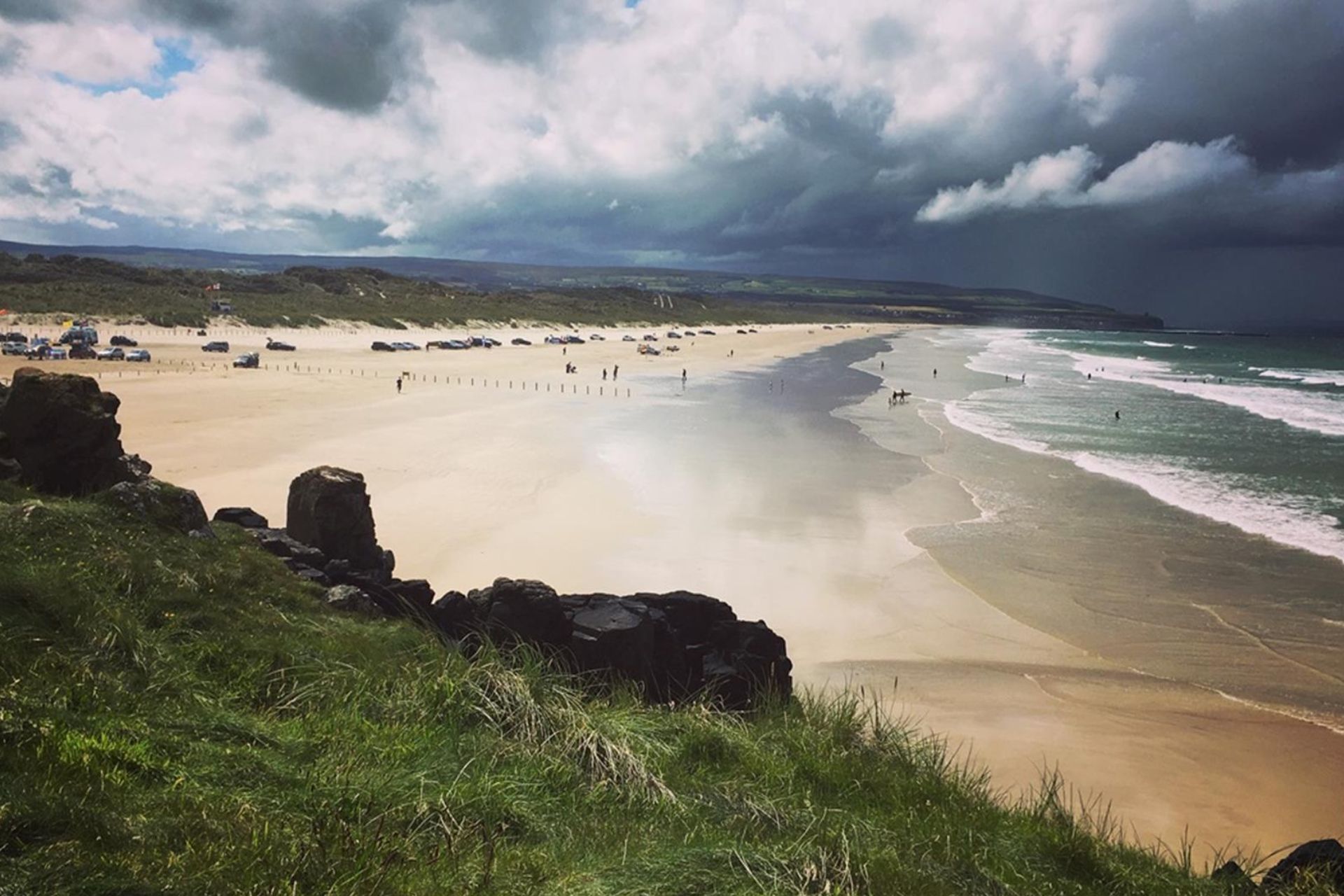
Credit: Discover Northern Ireland
Portstewart Strand’s golden sands made it a great stand-in for the southern part of Westeros. Jaime Lannister and Bronn used the dunes here to rescue Myrcella Baratheon while disguised as Martell soldiers. Portstewart Strand is a two-mile long beach in Portstewart, County Londonderry, Northern Ireland. It stretches between the popular Portstewart resort and the River Bann’s mouth, known as the Barmouth.
In 2000, the dune system was added to the Bann Estuary Area of Special Scientific Interest. This area is home to rare and delicate habitats. Visitors can see various species of butterflies and orchids, including the bee orchid, on marked trails.
20. Castle Ward, Strangford: Winterfell
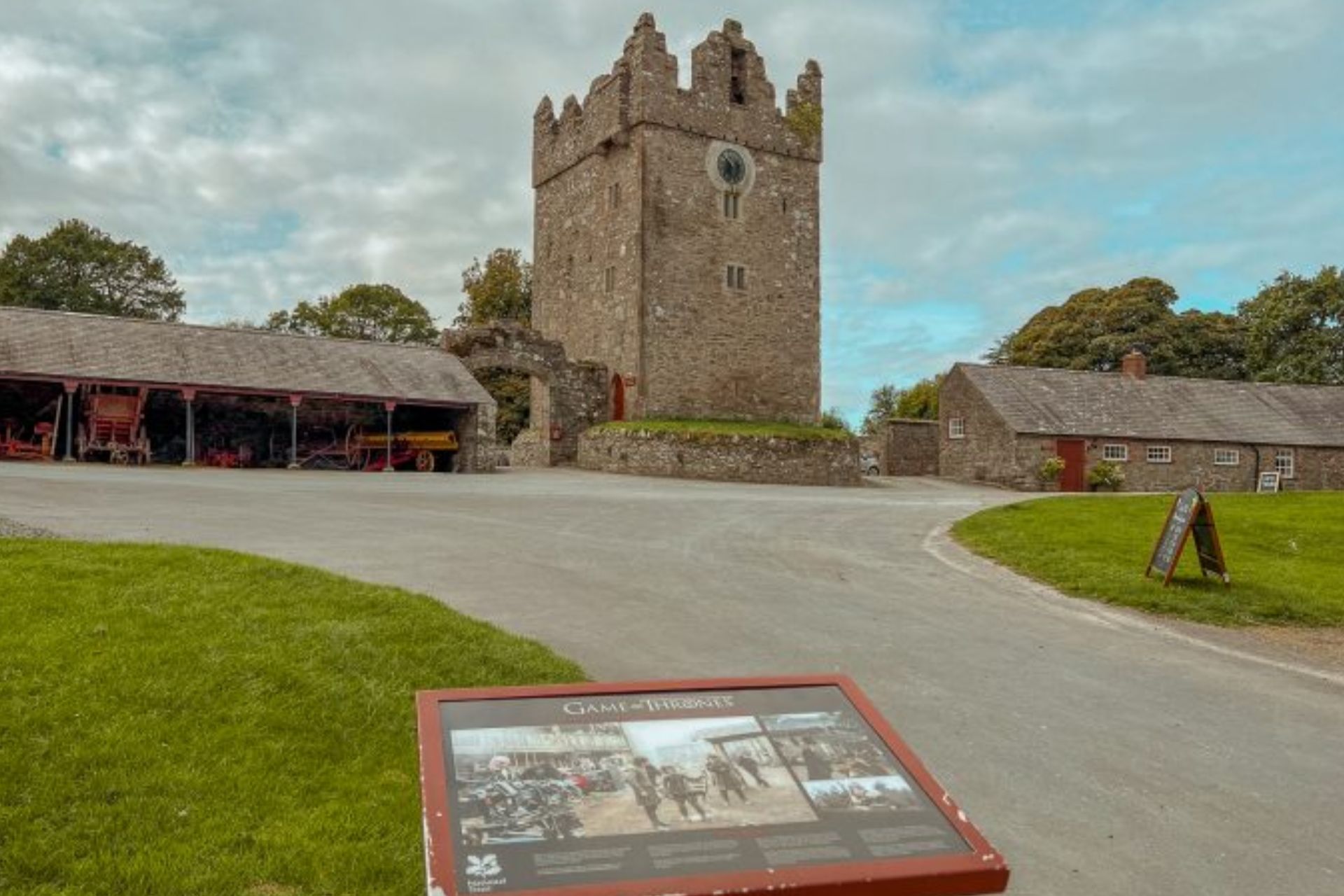
Credit: Third Eye Traveller
Castle Ward, located in County Down, Northern Ireland, served as a key location for House Stark in the Seven Kingdoms. This 820-acre property, managed by the National Trust, sits near Strangford village. It overlooks Strangford Lough and is just 7 miles from Downpatrick and 1.5 miles from Strangford.
Castle Ward is open to the public and features 332 hectares of landscaped gardens. The estate includes a fortified tower house, a Victorian laundry, a theatre, a restaurant, a shop, a sawmill, and a working corn mill. It also has a shore along Strangford Lough. From 1985 to 2010, it hosted the Castleward Opera, an annual summer festival.
The most notable feature of Castle Ward is its dual architecture. The entrance side displays a classical Palladian style with columns and a triangular pediment. The opposite side, however, showcases Georgian Gothic elements, including pointed windows, battlements, and finials. This architectural contrast extends throughout the house.
21. Pollnagollum Cave, Fermanagh: Beric Dondarrion’s Hideout
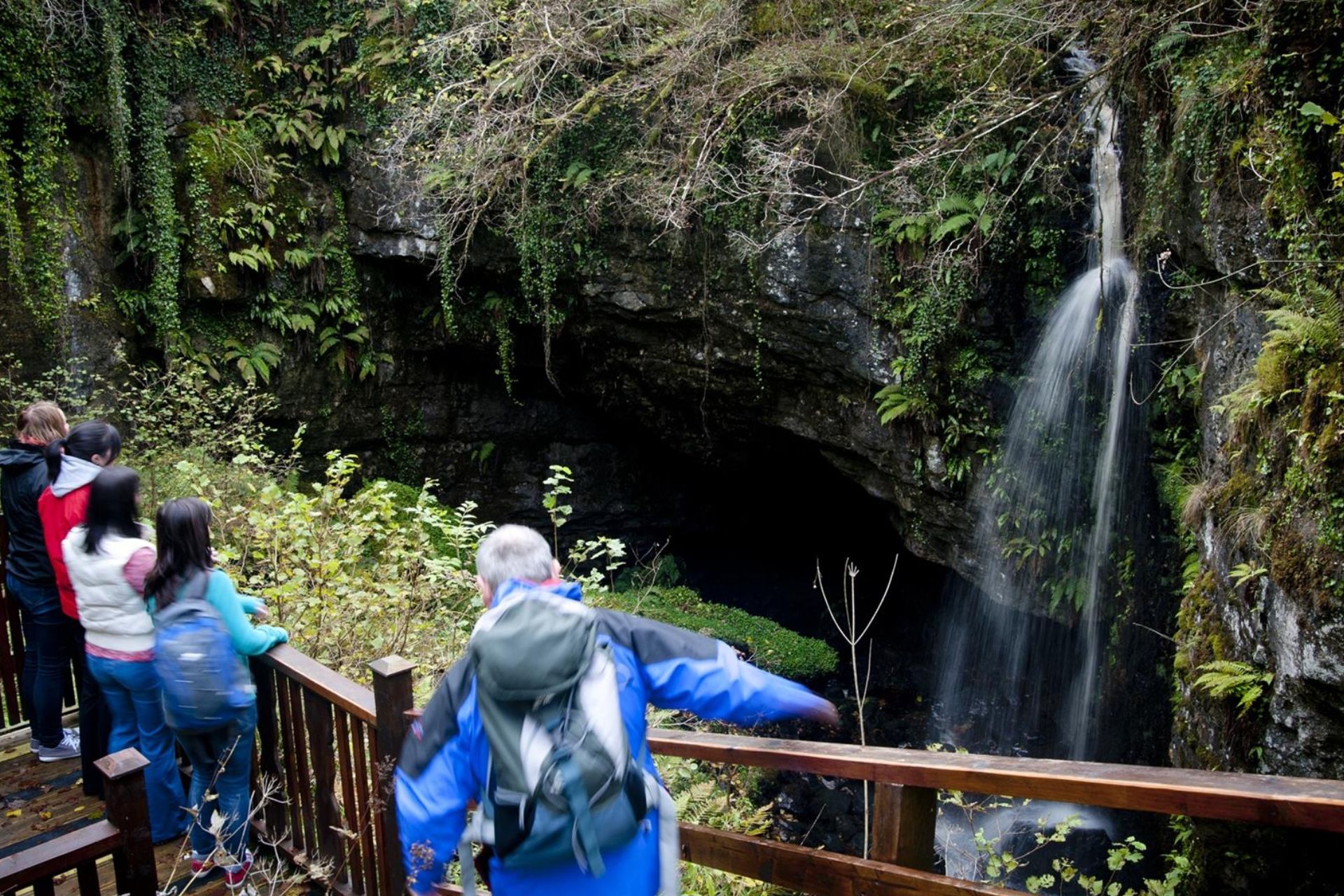
Credit: Discover Northern Ireland
In season 3, the ‘Brotherhood Without Banners’ used Belmore Forest as their secret hideaway. Belmore Forest covers much of Belmore Mountain, which reaches about 398 meters, making it the second highest point in Fermanagh. The forest offers stunning views of Boho, Lower Lough Erne, Lough Navar, and, to the east, Brougher Mountain with its TV masts.
This area is central to Fermanagh’s Boho cave country. Under the forest lies a maze of caves, attracting cavers from all over. Pollnagollum Cave, used in Game of Thrones, is one of these caves. A viewing platform at Pollnagollum Cave offers a great view of the cave entrance and a 12-meter waterfall cascading down a limestone cliff. The stream flows underground for about 1.8 kilometers before resurfacing along the north bank of the Aghanaglack River.
22. Audley’s Castle, Downpatrick: Winterfell
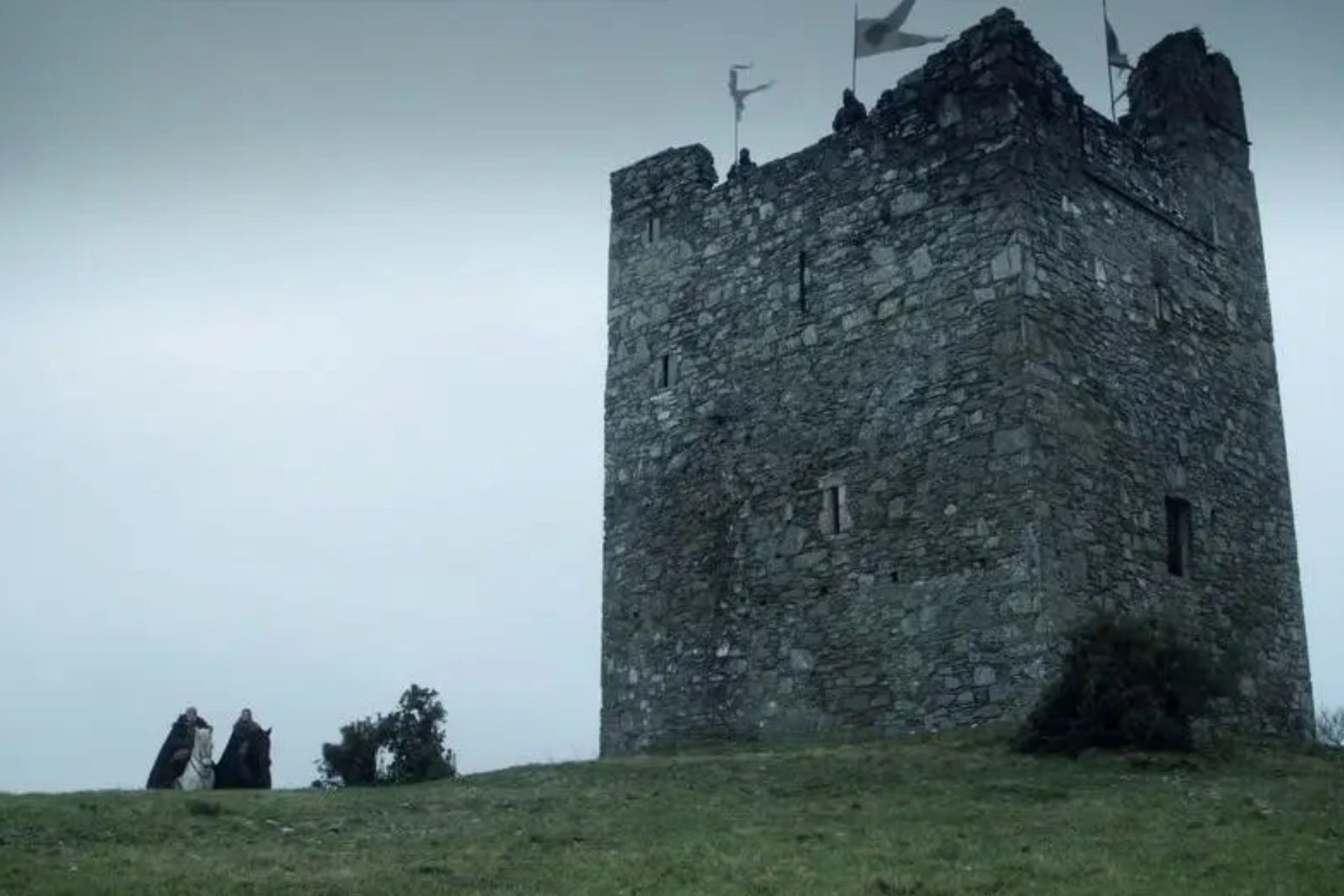
Credit: HBO
Audley Castle at Strangford Lough served as a key filming location for Game of Thrones in seasons 1 and 2.
The site has several paths leading to the castle. Audley’s Field was also featured in Game of Thrones, where much of the drama unfolds. You can visit and explore Robb’s Trail, part of two self-guided cycling tours provided by Clearsky Adventure Centre on the Castle Ward Estate.
In Season 1, Audley’s Field is where King Robert Baratheon and his party arrive at Winterfell. In Season 2, it serves as Robb’s camp and the place where he first meets Talisa. Later, Audley’s Field becomes the site where Alton Lannister is imprisoned with Jaime Lannister and meets his end.
The castle is named after the Audley family, who owned it in the 16th century. The Ward family bought the estate in 1646 and used the castle in 1738 as a striking feature along Castle Ward’s artificial lake, Temple Water.
Audley’s Field also appeared in Dracula Untold, another film shot in Northern Ireland.
23. Toome Canal, Lough Neagh: Old Valyrian Canal
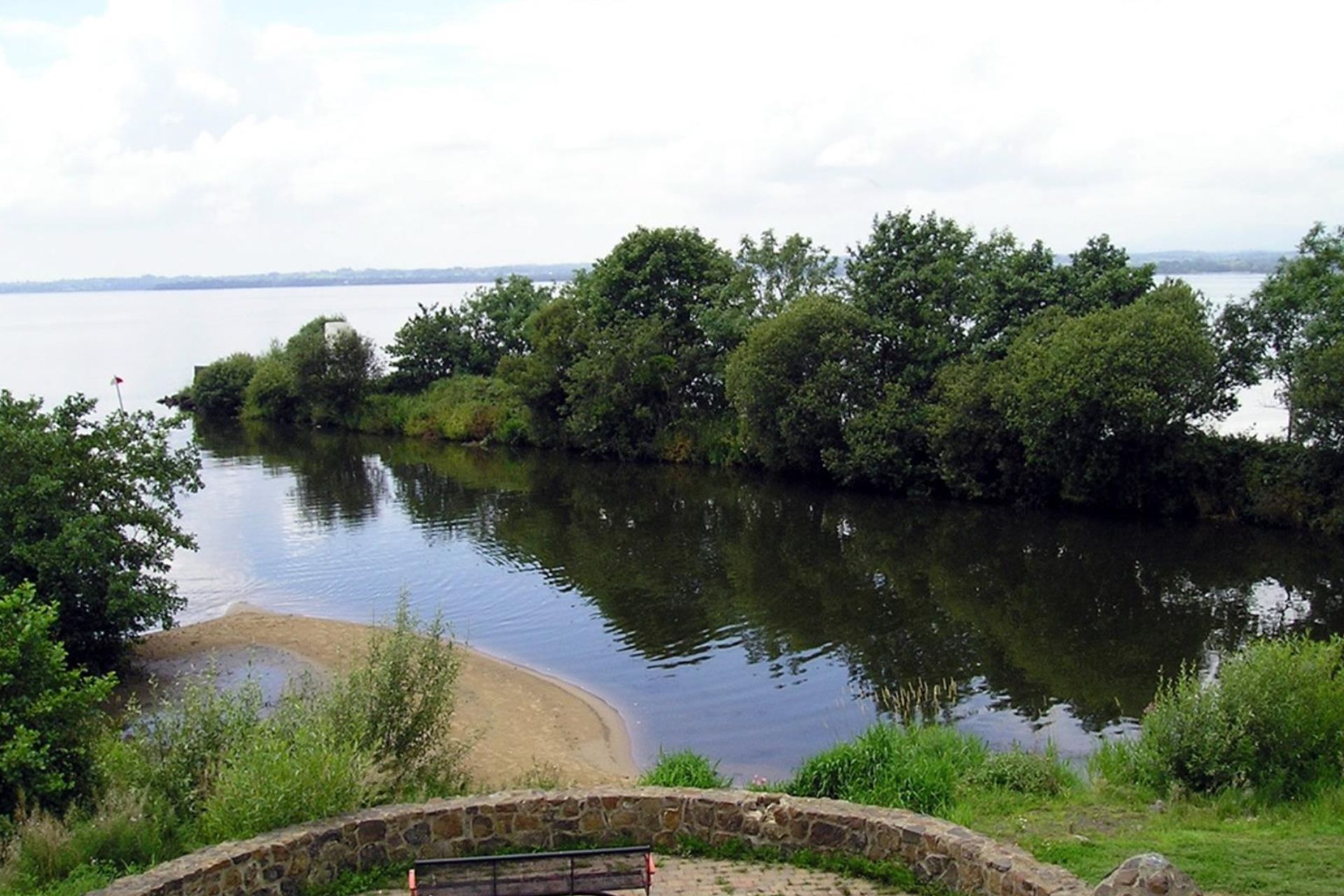
Credit: Discover Northern Ireland
In Season 5, Jorah Mormont, now disgraced, captures Tyrion. He binds and gags Tyrion, then throws him into a stolen boat before sailing to Meereen.
Toome, also known as Toomebridge, is a small village in County Antrim, Northern Ireland, located on the northwest corner of Lough Neagh. It offers peaceful waters and beautiful riverside views along the Toome Canal.
The Toome Canal walk is an easy fifteen-minute loop, ideal for walkers of all ages and abilities. On your right, you’ll see the remains of an old railway bridge over the Bann. As you continue, you’ll pass several sluice gates on the Lower Bann. The walk leads you to the edge of Lough Neagh, where you can enjoy wide views of the lake.
24. Leitrim Lodge, Newry: North of Winterfell
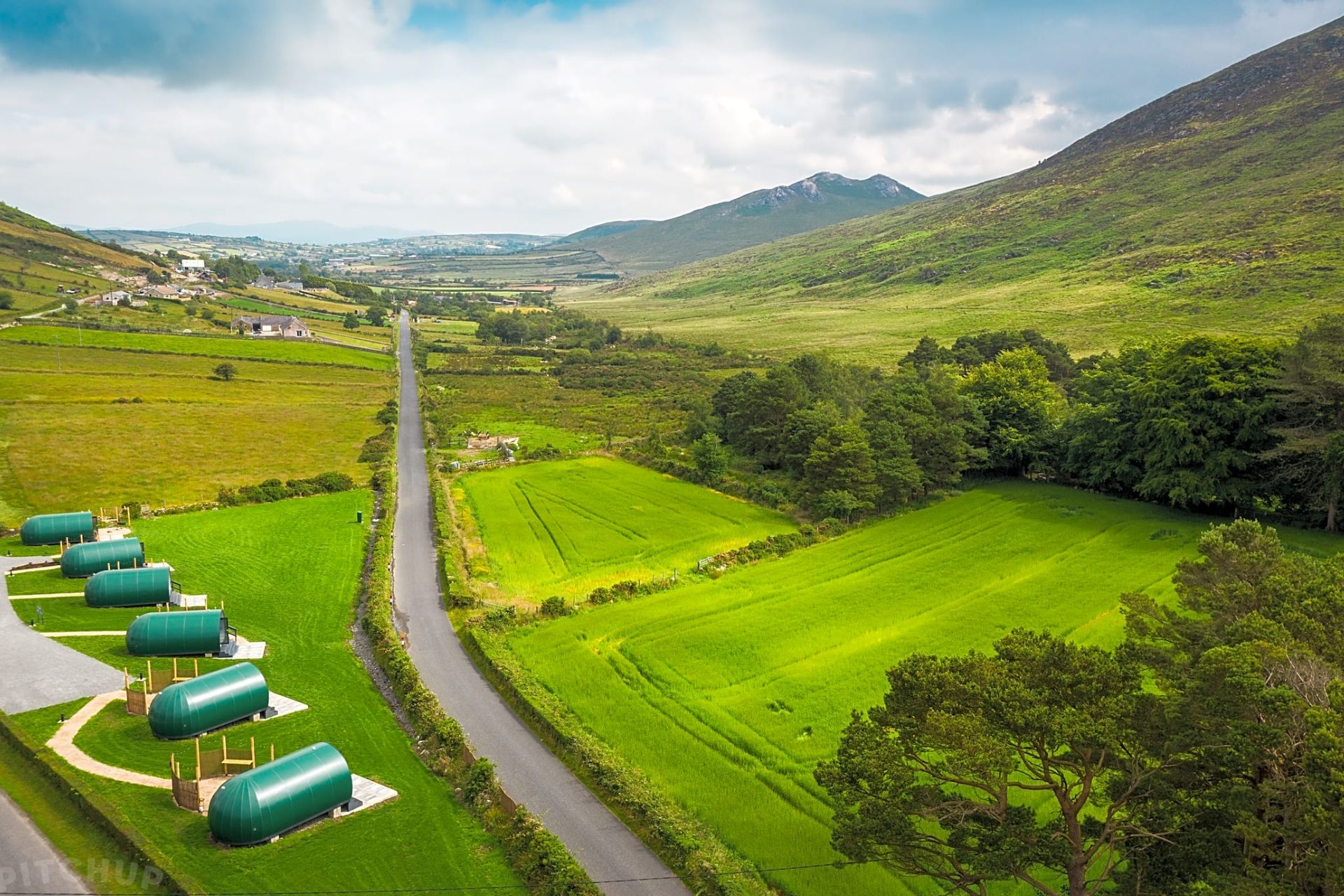
Credit: Pitchup
Bran and Rickon Stark hide in the crypts at Leitrim Lodge after Theon takes Winterfell.
Leitrim Lodge offers stylish glamping pods for couples and families, set in Ireland’s Rocky Mountain range. You can stay in one of six luxury pods at the base of the scenic Mourne Mountains. The Mourne Mountain Region is designated as an area of Outstanding Natural Beauty.
25. Dunluce Castle, Bushmills: Pyke Castle
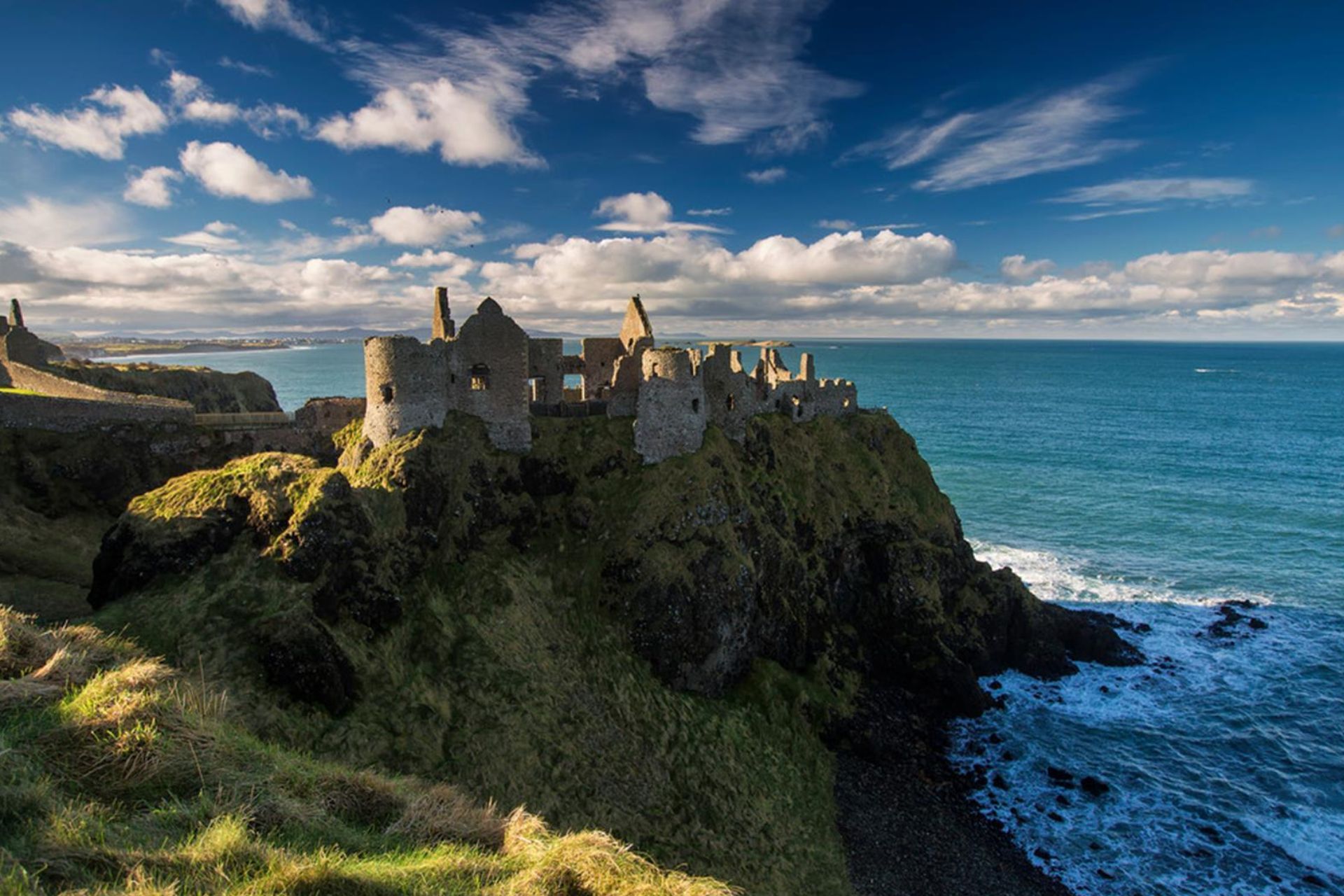
Credit: Discover Northern Ireland
The ruins of medieval Dunluce Castle stand in for Pyke Castle, home of the House of Greyjoy in the Iron Islands. Dunluce is one of the most scenic and romantic castles in Ireland. It has traces of settlement from the first millennium, but the current ruins are mostly from the 16th and 17th centuries. The McQuillan and MacDonnell clans both lived here, and there are historical and archaeological exhibits open to the public.
Nearby, Magheracross Viewing Point offers stunning coastal views and is a great place to stop while traveling the coast road.
Dunluce Castle, perched on dramatic coastal cliffs in north County Antrim, was first built by the MacQuillan family around 1500. The earliest record of the castle dates to 1513. The MacDonnell clan seized it in the 1550s, led by the warrior chieftain Sorely Boy MacDonnell.
In the 17th century, the castle became the seat of the earls of Antrim and saw the creation of a small town in 1608. Visitors can explore the remnants of Dunluce Town and its cobbled streets. The castle is also known for stories of a banshee and the night the castle kitchens fell into the sea in 1639.
26. Titanic Studios, Belfast
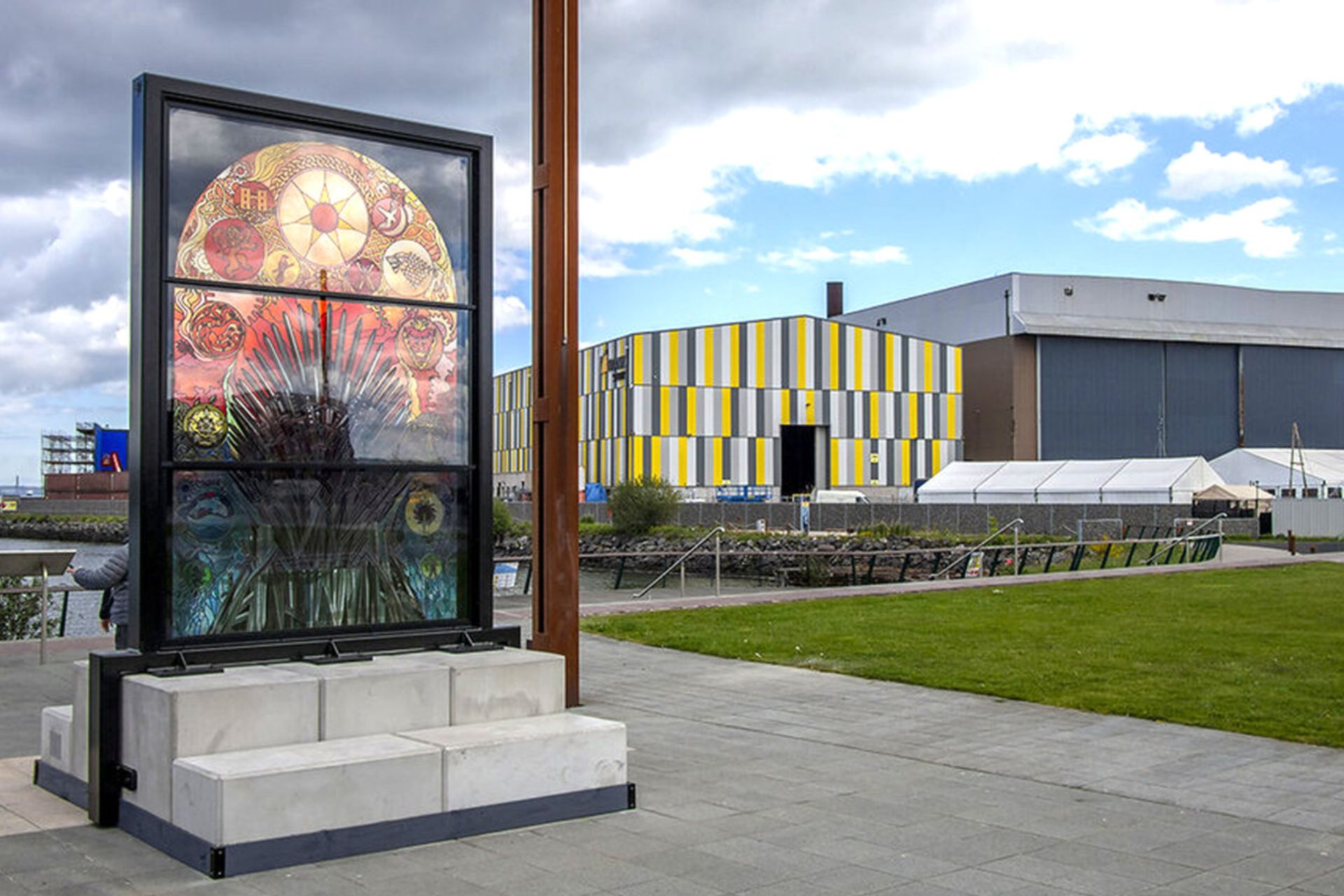
Credit: Harcourt Developments
Titanic Studios is one of Europe’s largest film studios and hosts many indoor shoots and fixed sets. Major producers like HBO, Universal, and Playtone use the facility. Titanic Studios has hosted international productions such as Game of Thrones, Your Highness, and City of Ember. It forms the core of Titanic Quarter’s expanding Media Campus.
The studio spans 106,000 sq.ft. and served as the main studio and post-production center for all eight seasons of Game of Thrones. This established Northern Ireland as a top location for film and TV production.
Read More: What happened during the Battle of the Burning Mill?
27. Titanic Quarter, Belfast
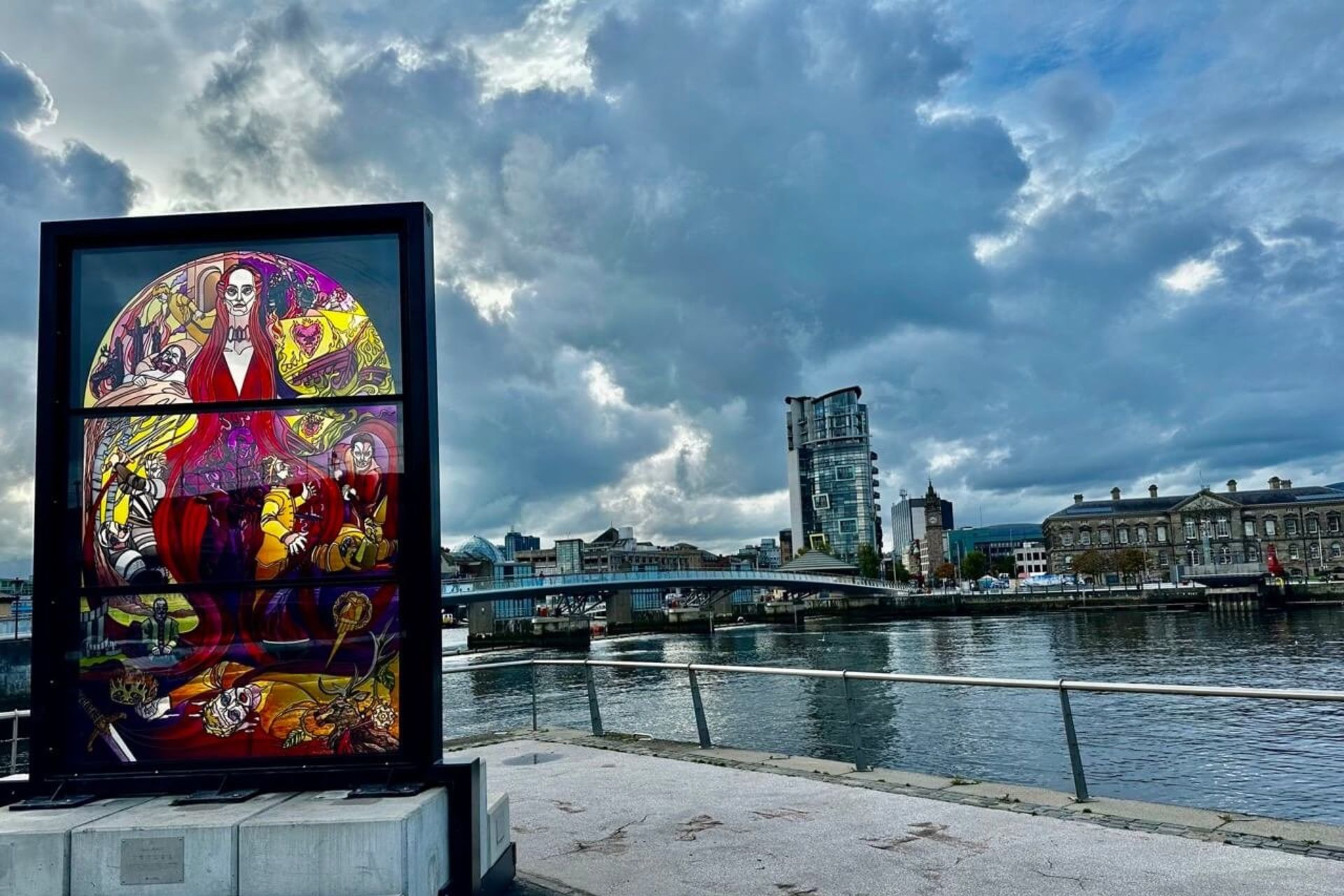
Credit: Traveling Mitch
Larger sets were sometimes built outdoors, like Kings Landing in season 8. Belfast’s Titanic Quarter is one of Europe’s biggest urban waterfront projects.
About 20,000 people live, work, visit, and stay here daily. The area now attracts more than 3.6 million visitors each year.
Titanic Quarter features major TV and film productions, the world’s largest Titanic visitor attraction, and popular waterfront housing. Located in Belfast’s Innovation District, it hosts over 100 national and international businesses.
Titanic Quarter is also leading the way in sustainable development, blending Belfast’s maritime and industrial heritage with future-focused growth.
Did your favorite spot make it to the list? Tell us in the comments below!
Stream House of the Dragon, Game of Thrones and more HBO Original series on Max. Sign up and save up to 20% with an annual plan.
-

 News3 days ago
News3 days agoGame of Thrones: Kingsroad now available on Steam on early access
-

 Humour5 days ago
Humour5 days agoGwendoline Christie’s fierce Severance Season 2 finale scene reminds fans of Brienne of Tarth from Game of Thrones
-
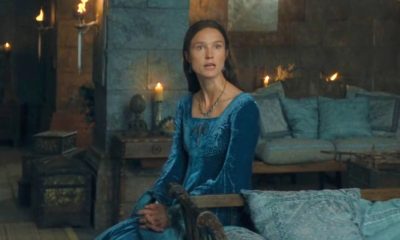
 News6 days ago
News6 days agoHouse of the Dragon Season 3 leaks reveal key details about Episode 4
-

 Interview2 days ago
Interview2 days agoGeorge R.R. Martin says The Winds of Winter is “coming pretty well”, wishes to finish it faster
-
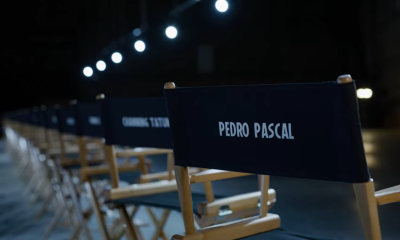
 News29 minutes ago
News29 minutes agoPedro Pascal is confirmed to be in Avengers: Doomsday

